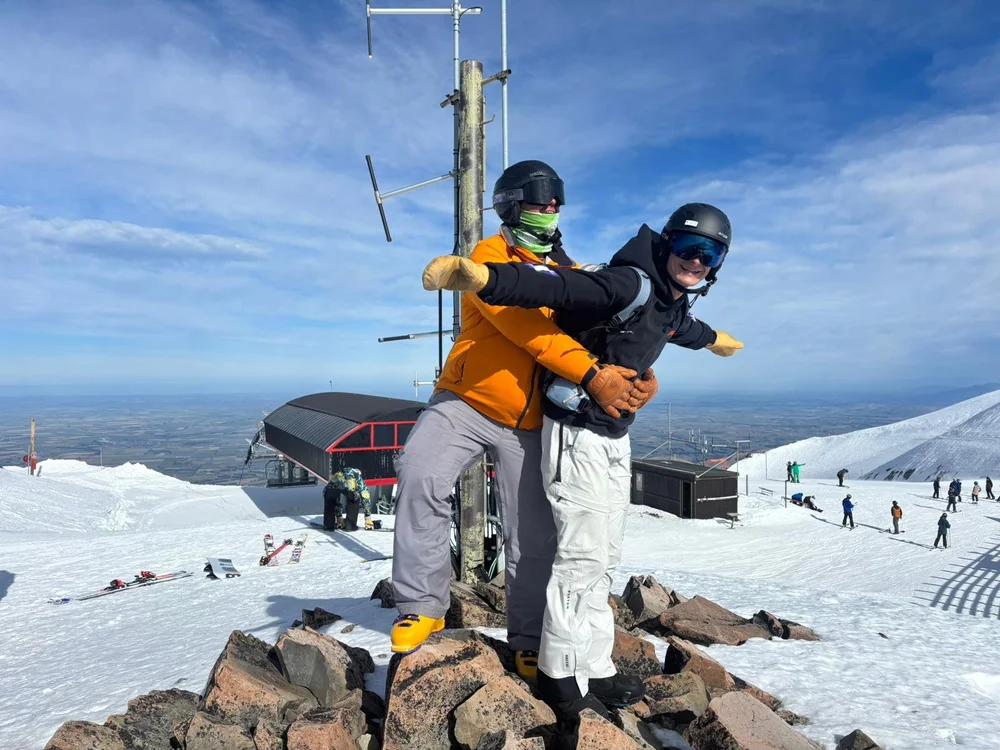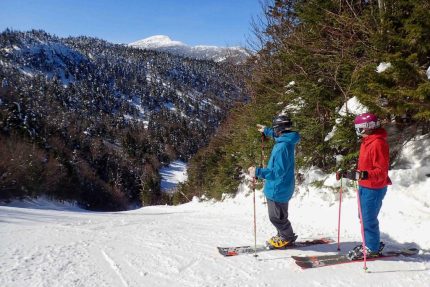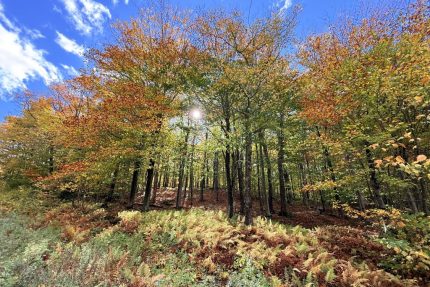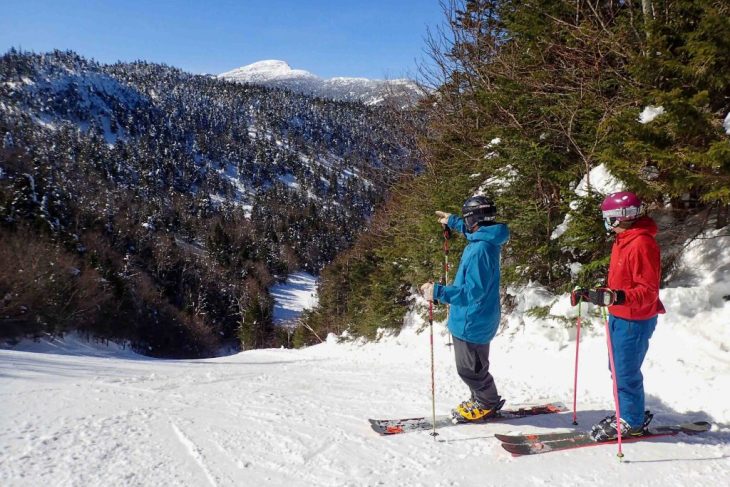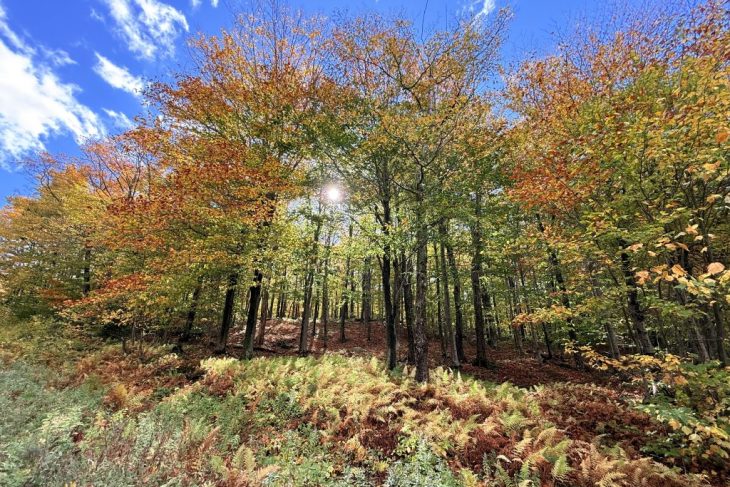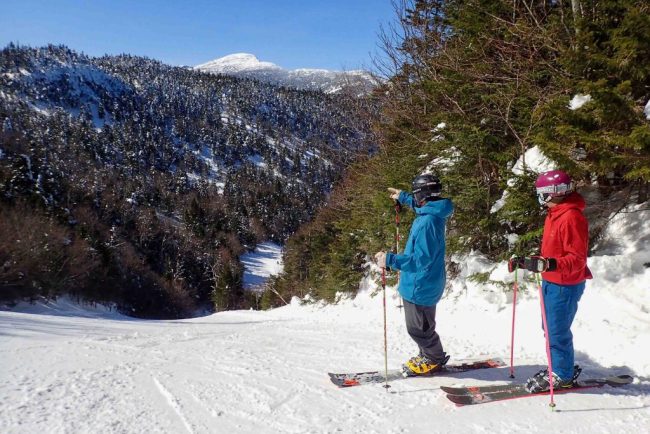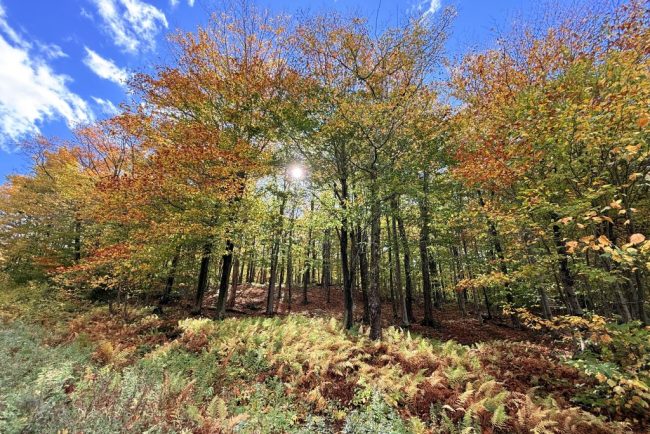Ski Magazine
Love to Ski Groomers? 8 Resorts Known for Their Blue Cruisers. Here’s where you can set an edge on the freshest corduroy, plus tips to take your carve to the next level. Read more on skimag.com Best Resorts To Ski Groomers Most people think of […]
ViewsMountain Review: Gunstock
MOUNTAIN SCORE #6 in New Hampshire 49 #116 Overall WRITTEN REVIEW MOUNTAIN STATS CATEGORY BREAKDOWN See our criteria 4 Snow: 5 Resiliency: 2 Size: 3 Terrain Diversity: 3 Challenge: 6 Lifts: 7 Crowd Flow: 6 Facilities: 7 Navigation: 5 Mountain Aesthetic: GOOD TO KNOW […]
MountainLeaf Peeping, the Smuggs Way
The Village is hopping, the leaves are popping, and the weather is just right. I was chatting with a fellow foliage reporter yesterday, and we came to the conclusion that there’s really no wrong way to enjoy leaf peeping, besides maybe going blindfolded. So, find […]
Views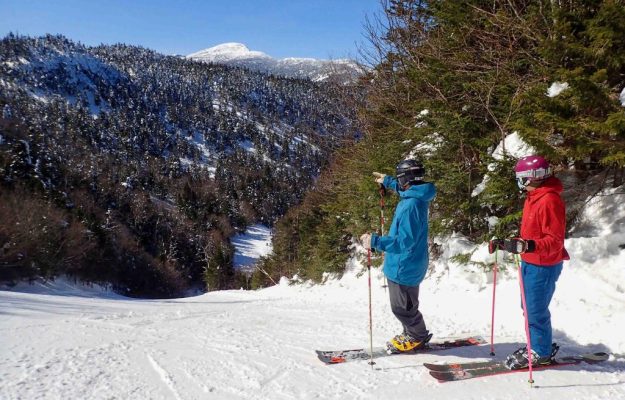
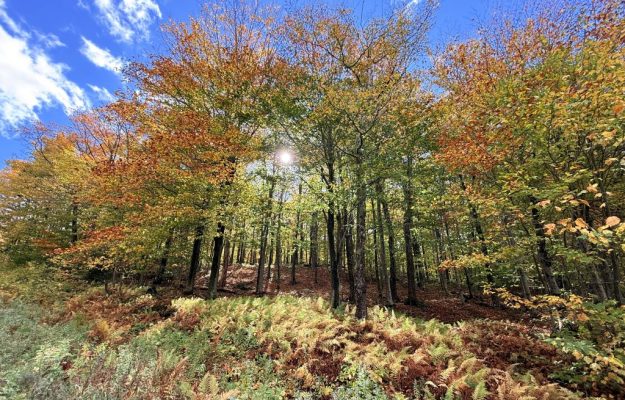
Powderhorn Planning to Replace West End Lift with High-Speed Quad
The nearly 15 minute ride time of the West End double will drop by more than 50% for the 2026-27 ski season. One of the longest lift rides in Colorado is expected to become drastically shorter for the 2026-27 season. That’s because earlier […]
Mountain
The nearly 15 minute ride time of the West End double will drop by more than 50% for the 2026-27 ski season.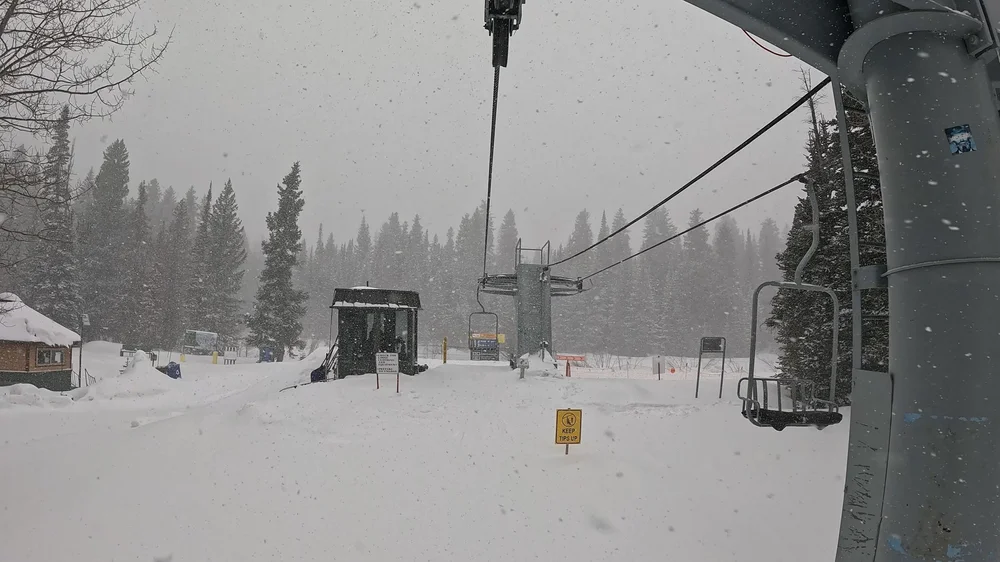
One of the longest lift rides in Colorado is expected to become drastically shorter for the 2026-27 season. That’s because earlier this week, far-western Colorado’s Powderhorn ski resort announced plans to replace its West End double chair with a used high-speed quad from Snowmass (pending U.S. Forest Service approval).
The West End lift currently serves around half of Powderhorn’s terrain, including much of its standout aspen-filled glade terrain, and is one of the longest remaining double chairlifts on the continent. Its ride time of 13.5 minutes is set to be cut by more than 50%, as not only will the new lift run twice as fast, but will also be 700 ft shorter, as the top part of the lift is incredibly flat.
This lift will be made of a mix of old and new, with many of the parts taken from the old Elk Camp lift from Snowmass. The lift will be built with Leitner-Poma of America (LPOA), which is headquartered in nearby Grand Junction, and it will be fully refurbished before it’s installed.
Powderhorn is a midsized ski area on the western slope of Colorado, located about an hour from Grand Junction. With a 1,650 foot vertical drop and an independently measured 845 skiable acres, no one will mistake Powderhorn for Vail or Breckenridge, but it has enough terrain for a day or two of skiing or riding.
For more information, check out Powderhorn’s press release here.
While crowds aren’t the biggest issue at Powderhorn, a capacity upgrade for the West End lift will make sure that stays the case in the coming years.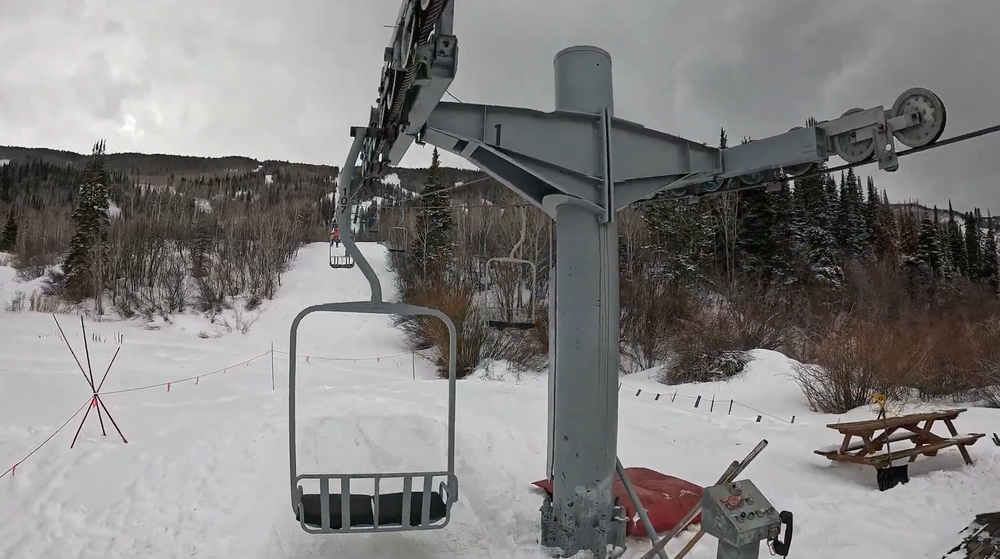
Our Take
Powderhorn often flies under the radar of Colorado’s bigger ski scene, as it’s hours west of Denver’s traffic and lacking in terms of the sheer size of isolated heavyweights like Telluride or Steamboat.
That being said, this new lift could put Powderhorn more on the radar for many people tired of the Front Range crowds. If approved by the U.S. Forest Service (which is not guaranteed yet), the new West End lift would cut ride times by more than 50 percent on that terrain pod, from the current agonizing 13.5 minute ride time to a much more palatable six or seven minute journey. The upgrade would also mean that all of Powderhorn’s terrain outside the Easy Rider beginner area would be served by high-speed lift service.
The lift won’t suddenly make Powderhorn Colorado’s top resort, but it will elevate the experience for skiers and riders looking for low crowds, advanced glades, and a vibe far removed from the Front Range chaos. For the fast-growing communities on the Western Slope, it will make for a much better experience for a skier or rider looking for low crowds, advanced glades, and something overall different than the craziness found in the Front Range.
Considering a ski trip to Powderhorn this year? Check out our comprehensive resort review here. You can also check out our Colorado ski resort rankings in video form below.
Mountain Review: Powderhorn
MOUNTAIN SCORE #18 in Colorado 58 #79 Overall WRITTEN REVIEW MOUNTAIN STATS CATEGORY BREAKDOWN See our criteria 7 Snow: 5 Resiliency: 5 Size: 6 Terrain Diversity: 6 Challenge: 5 Lifts: 8 Crowd Flow: 3 Facilities: 7 Navigation: 6 Mountain Aesthetic: GOOD TO KNOW […]
MountainMOUNTAIN SCORE
58
CATEGORY BREAKDOWN
7
Snow:
5
Resiliency:
5
Size:
6
Terrain Diversity:
6
Challenge:
5
Lifts:
8
Crowd Flow:
3
Facilities:
7
Navigation:
6
Mountain Aesthetic:
GOOD TO KNOW
1-Day Ticket: $89-$109
Pass Affiliation: Indy Pass
On-site Lodging: Yes
Après-Ski: Limited
Nearest Cities: Grand Junction (45 mins)
Recommended Ability Level:

+ Pros
-
Lower crowds than Colorado competitors
-
Standout advanced-level glades
-
Lower price than most other Colorado areas
-
Easy-to-understand mountain layout
– Cons
-
Smaller size than advertised
-
Slow, low-capacity West End lift
-
Lack of beginner and true expert terrain
-
Nearest après options are a ways away in Grand Junction and Palisade
MOUNTAIN STATS
Skiable Footprint: 845 acres
Total Footprint: 1,600 acres
Lift-Serviced Terrain: 100%
Top Elevation: 9,850 ft
Vertical Drop: 1,650 ft
Lifts: 5
Trails: 42
Beginner: 20%
Intermediate: 50%
Advanced/Expert: 30%
Mountain Review
When skiers and riders think of Colorado resorts along the I-70 corridor, they may conjure up images of weekend warriors congesting roads and long lift lines, but the further from the Front Range you drive, the less of a concern this becomes. Case in point: Powderhorn Mountain, an independent resort located over 4 hours west of Denver, and about 45 minutes east of Grand Junction. While this no-frills, locals-focused mountain doesn’t have the most exciting terrain compared to your typical mega-resort, Powderhorn puts emphasis on value and accessibility for the everyday skier. Is this enough to justify going out of your way to catch some laps?
Powderhorn is located on the northern slope of the largest flat-topped mountain in the world, and as a result, it sees some notably sporadic snowfall patterns when storms roll through.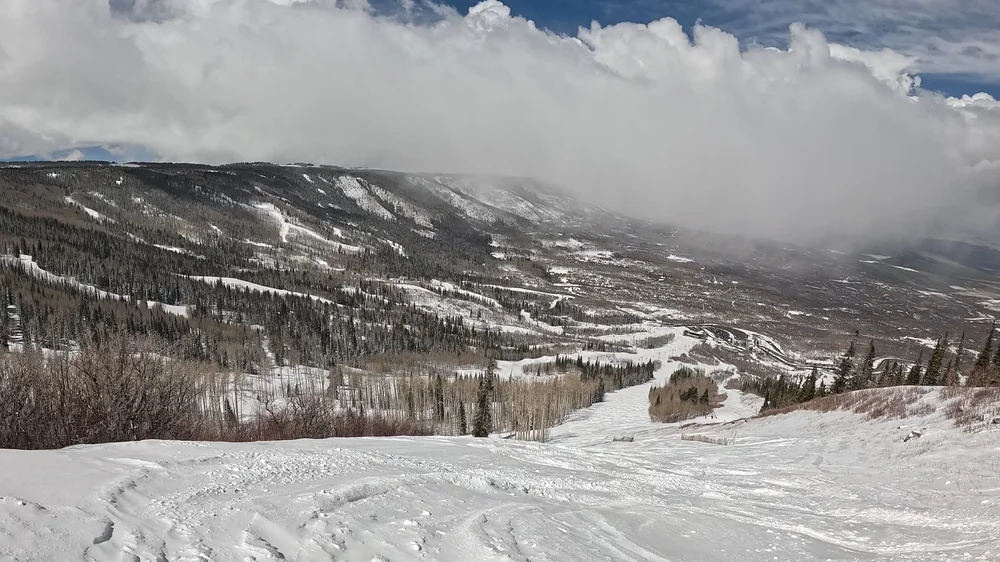
Snow Quality and Resiliency
Powderhorn rises 1,650 feet from top to bottom, which is respectable for a regional spot. The resort’s base resides at 8,200 feet, just above a semi-arid high-desert. This environment provides high quality light and airy snow when conditions are favorable, but it also results in big swings in snowfall between seasons. Higher accumulation years can see totals over a solid 200 inches, but bad years can be especially unfavorable, with natural snowfall dipping well below 100 inches. Even on a daily basis, weather can change sporadically; because storms circle back around the flat top after clearing up, conditions can alternate between clear and heavy snow in just a few minutes.
Snowmaking exists on a handful of top-to-bottom groomer runs surrounding the Flat Top Flyer lift, somewhat insulating the mountain from years of lower accumulation. Investment in these systems in recent years have allowed for a longer season for at least part of the mountain, now averaging from late November or early December to early April.
With 845 skiable acres and a 1,650-foot vertical drop, Powderhorn is smaller and shorter than the major Colorado destination ski resorts.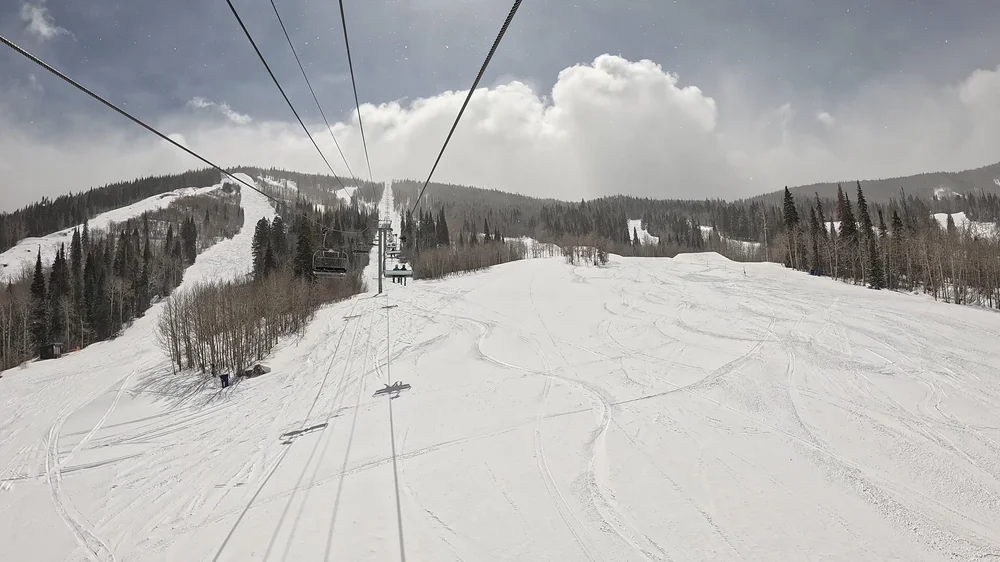
Size, Terrain Layout, and Ease of Navigation
Powderhorn claims to have a 1,600 acre “permitted” footprint, which, while true, is somewhat misleading. This includes the full footprint of land leased to the resort from the US Forest Service, so in reality, we calculated Powderhorn only has about 845 acres of in-bounds skiable terrain.
Located on the northern slope of the Grand Mesa, which is billed as the largest flat-top mountain in the world, Powderhorn provides expansive views into the valleys and red-rock desert landscape carved out by the Colorado river and its tributaries. To the skier’s left, an arm of the mesa wraps around the flank of the resort, cutting off views of major population centers and leading to a feeling of isolation. That said, because of the nature of a Mesa, you never feel like you’re truly on a mountain peak, and the resort lacks the sweeping 360 degree views that would accompany it.
Powderhorn’s layout is generally easy to understand, but getting to and from the West End area can involve frustratingly flat trails.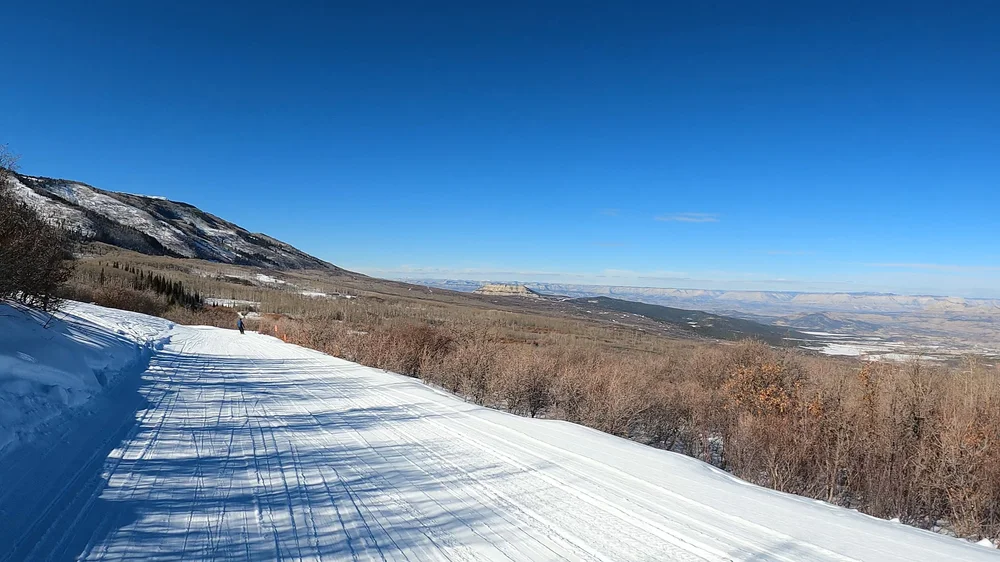
The resort is laid out in two wings with only one major lift serving each, creating a sort of double-peaked footprint. The Flat Top Flyer, the resort’s only high speed quad, runs out of the base and serves the eastern flank, while the West End lift, a slow fixed grip double, serves the western flank. The West End’s base can’t be accessed by car, and requires that guests must first take the Flat Top Flyer or Easy Rider (the minor lift serving the learner area). There are several runs that allow you to cross from one end to the other without much trouble, but many of these are flat catwalks that can slow down the progress, especially Tenderfoot from the top of the West End, Boardwalk going to the West End base, and the upper portion of Bill’s Run off Flat Top Flyer.
Beginner Terrain
There isn’t much on the table for beginners at Powderhorn, but the learner area around the Easy Rider lift provides a couple of magic carpets, gentle wide groomed runs, and tree trails for skiers taking their first turns. Beyond that, the opportunities for progression into intermediate runs is limited to a green switchback coming from the top of the Flat Top Flyer which then splits off into a couple of more wide open groomed runs toward the bottom.
Powderhorn has plenty of intermediate cruisers, with red-rock desert views to boot.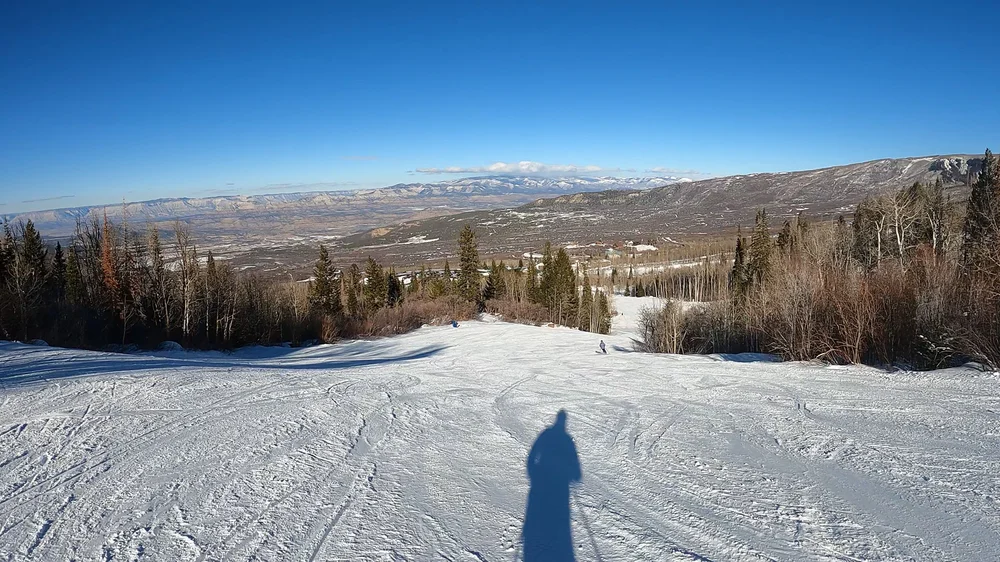
Intermediate Terrain
Intermediate skiers have much more to work with on the mountain; groomed blue runs act as the web stringing the resort together from all corners while cutting around smaller pockets of trees. They’re all pretty similar to one another, though some of the blue runs around the West End can be steeper than on the rest of the mountain. Grooming is solid and plentiful across the footprint.
Terrain Parks
You’ll find two parks on Upper and Lower Peacemaker, easily lapped via Flat Top Flyer, with small and medium sized jumps, boxes, and rails at the time of our visit.
Advanced and Expert Terrain
The mountain’s advanced terrain can be split into two pods. Black Diamond runs off the Flat Top Flyer are are long and moguled, with some options for tree skiing. Runs like Wonderbump and Cannonball (though the latter is more a single black than double) take a good amount of stamina to power through.
Powderhorn has some nice steeps and excellent glades, but experts should be able to handle everything.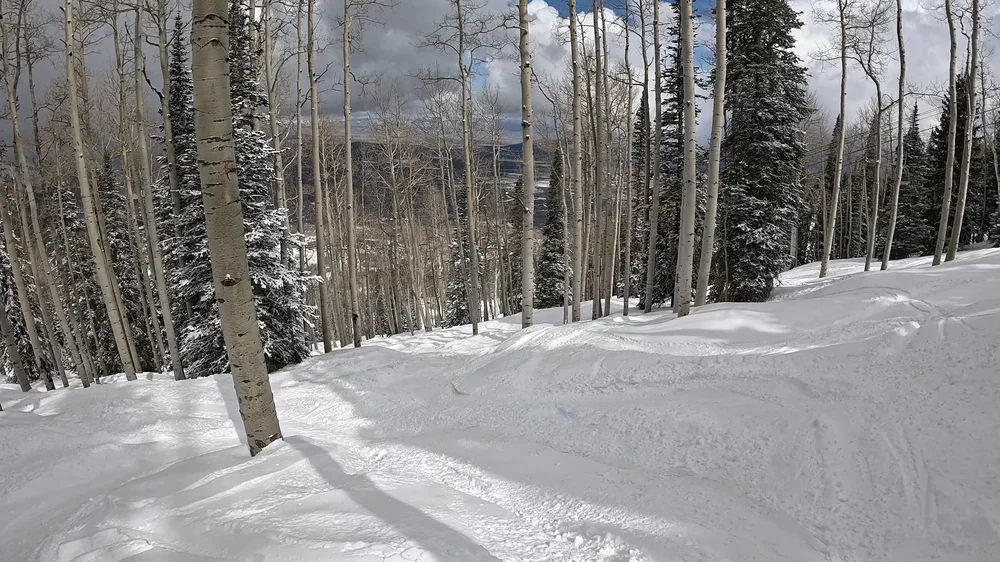
If you really want tougher terrain, you’ll be consistently spending time in the West End. The West End maintains the best terrain on the mountain, with a wider variety of moguled black diamond runs and a solid offering of steep glades. The standout here are the boulder fields dotted near the lift path, which provide some opportunities for deep pivot turns and can act as smaller cliffs to launch off of. Of course, since these tend to stick further out of the ground, they’re more likely to be closed during the early and late season.
Unfortunately, you’ll need to ride the ancient West End lift to effectively lap these runs, and it’s a slog at 12-15 minutes per lap. A higher speed upgrade is really the only major lift infrastructure improvement the resort could benefit from.
There’s almost no truly expert level terrain on the mountain, and the only run that would really qualify as such is Mudslide, a sweet run with pitches steeper than the rest of the mountain featuring gladded moguls and boulders. But even that’s short lived, almost immediately dumping into the more mild Cow Camp run.
The totality of all these runs might amount to a single advanced zone at a larger resort, but it gets the job done with a solid day’s worth of exploration, and can provide some serious fun in untracked snow.
TRAIL MAP
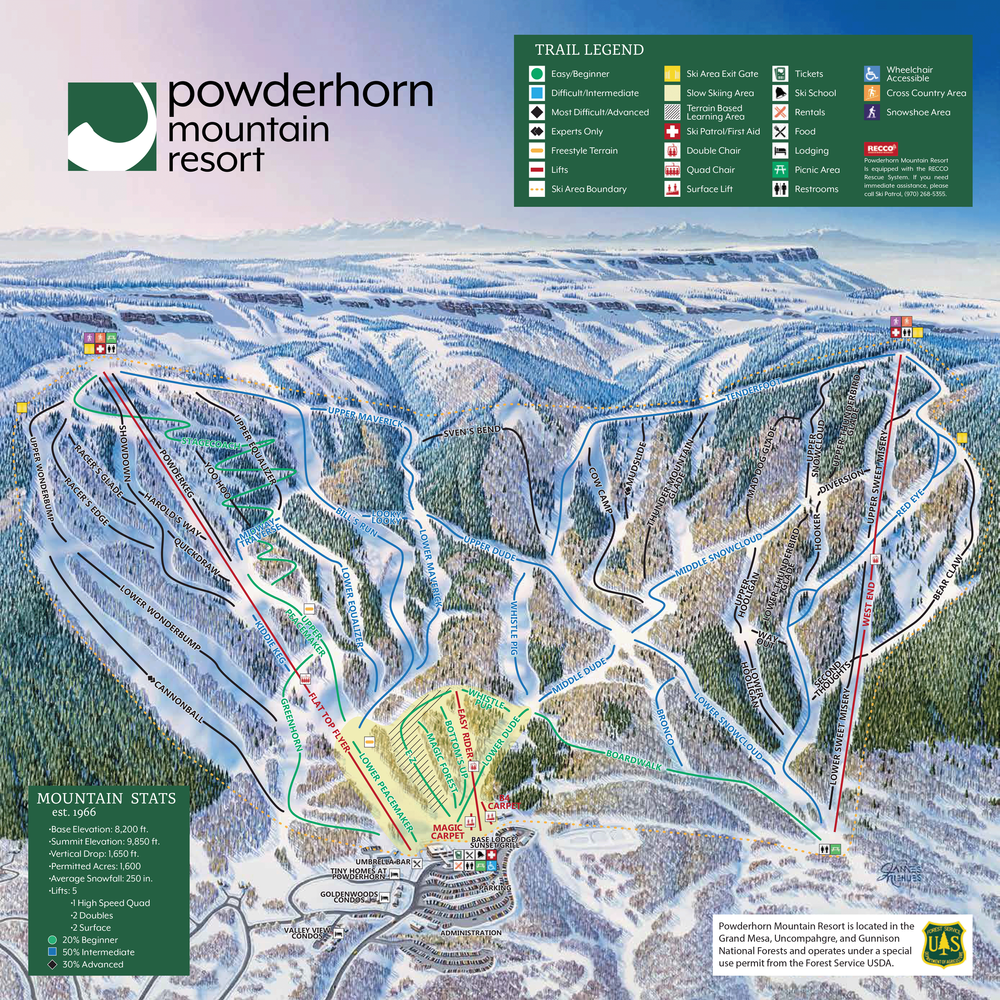
Uphilling
Powderhorn allows uphilling on a number of routes for low-priced day passes or an uphilling season pass. If you buy a full downhill season pass, an uphill pass is included.
Crowd Flow
Powderhorn sees low crowds, mostly serving locals from the Grand Junction and Palisade area. Even with a smaller footprint, pockets of powder can stick around for days after a storm. Lift lines longer than a couple minutes are rare, even on weekends and holidays, though small lines can occasionally form around the West End lift due to its lower capacity. The lack of serious traffic creates a laid back and unpretentious atmosphere at the resort.
Powderhorn rarely sees major crowds, with lift lines usually occurring only on the busiest weekends and holidays.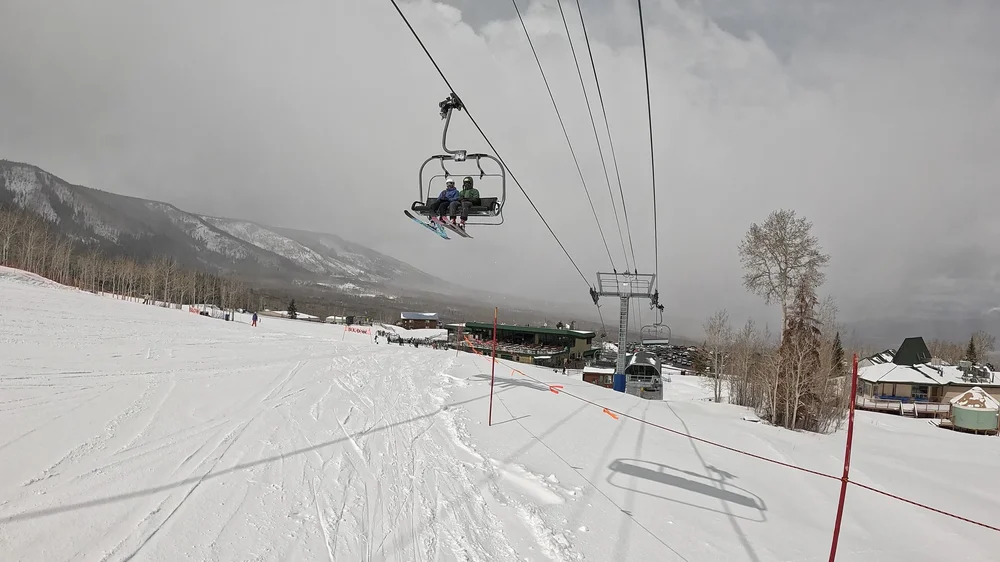
Facilities, Food and Après
Facilities are pretty sparse at Powderhorn—you’re not coming here for the pomp and circumstance of a destination mountain. The base lodge maintains functional staples like the ticketing office, rental shop, and restrooms. They have a simple grill with burgers and fries priced at non-extortion prices, a cafe, and taco truck serving lunch. Beyond the base, there are just a couple of porta-potties and ski patrol huts scattered across the mountain, so if you’re hungry or thirsty you have to head back down or pack a lunch.
For après, there’s a circular tented Umbrella Bar located right at the bottom of the Flat Top Flyer, serving local brews and wines in a relaxed atmosphere.
If you want more options, there are a few more places to eat and drink around the tiny town of Mesa, CO, just 10 minutes down the road. For any real kind of variety, you’ll need to drive to Palisade (apparently an up and coming wine region), or further along to Grand Junction, the biggest city on the Western Slope with a plethora of restaurants and bars.
Powderhorn has a nice and spacious base lodge, but there are no facilities besides porta-potties elsewhere at the resort.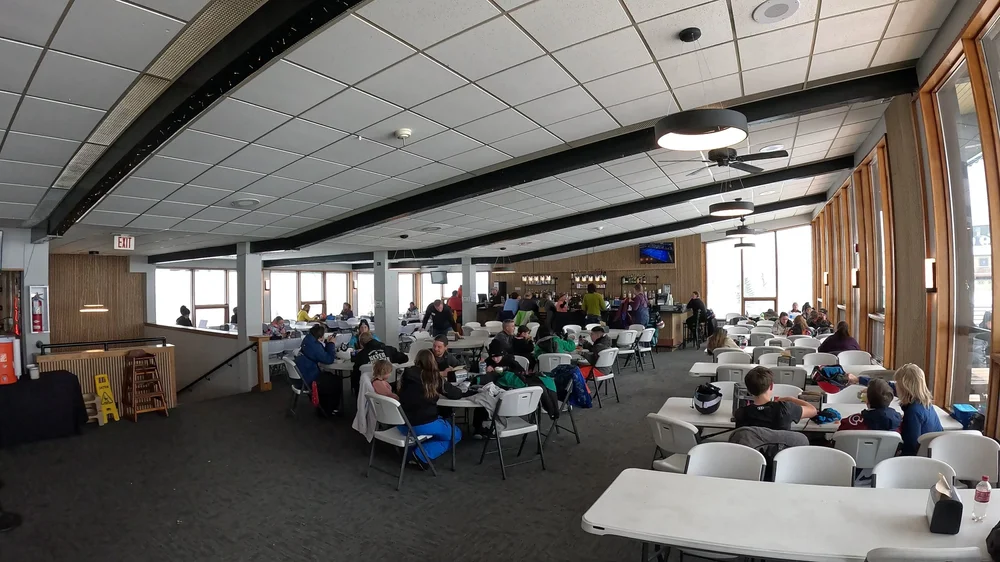
Lodging
The Goldenwoods Condos and some Tiny Homes are available per night just steps from the base. If you’re willing to drive, you can find some more options in Mesa, as well as some smaller lodges and cabin rentals in the surrounding area. For cheaper options, you’ll have to commute from Palisade or Grand Junction.
Getting There
The resort is located 45 minutes east of Grand Junction via I-70 and State Highway 65. Grand Junction’s airport can be a good option anyway to access western CO resorts like Telluride or Aspen for those who don’t want to brave Vail and Loveland Pass via Denver. Otherwise, Powderhorn is also 1.5 hours north of the Montrose Regional Airport, up and over the Grand Mesa and its scenic byway, or about 4.5 hours west of Denver International Airport.
Public transit to the resort is nonexistent, but parking is ample and free on a first-come, first-serve basis, with a circulator shuttle picking skiers up from lower lots on busier days.
Pass Affiliation and Partner Resorts
Powderhorn is majority owned by Pacific Group Resorts, a multi-mountain owner whose name flies under the radar in the North American ski scene. Smaller companies owning multiple mountains are increasingly rare in a world where headlines are dominated by Vail Resorts and Alterra gobbling up as much competition as possible. Most of these remaining smaller operators usually have a regional focus, but PGRI is something of an anomaly with resorts spread out geographically across the continent.
Powderhorn season pass holders get ticket access to its PGRI sister mountains (Jays Peak, Wisp Resort, Ragged Mountain, Wintergreen and Mt. Washington), as well as several days at other independent resort partners (Monarch, Loveland, Silverton, Eagle Point, and Sunlight).
Powderhorn is also available on the Indy Pass with no additional blackout dates, but blackout dates on the Indy Base Pass apply.
Despite its regional orientation, Powderhorn has some nice condos for on-site lodging.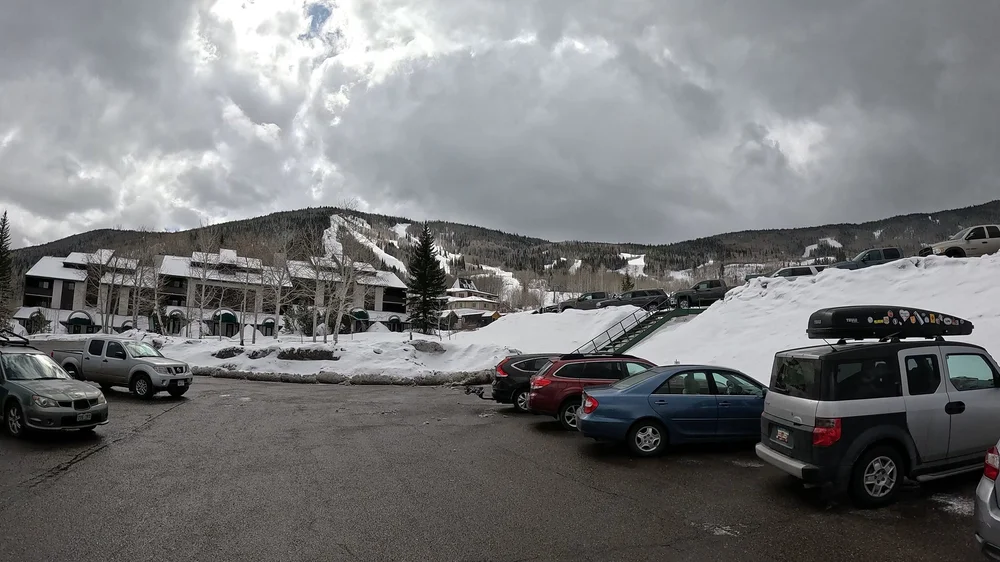
Verdict
Powderhorn isn’t going to blow anyone expecting a destination experience away with its offerings. It’s no true fly-to resort and experts need not apply, but for the average skier who’s looking for a good deal with solid intermediate and advanced offerings, Powderhorn punches above its weight. It combines a non-pretentious attitude and low crowd flow while being a step above competitors with spartan infrastructure and beginner terrain options. The value proposition, inclusion on the Indy Pass, and handful of partner resorts mean that Powderhorn could make sense as a stop on a greater roadtrip of independent ski mountains, or as a solid regional option if you’re already in the area and want to get some laps in.
Pricing
Full-day adult tickets range from $89 to $109, with a variety of discounts for half-day tickets, buying them in advance online, or for kids. They also offer further discounts for access limited to the Easy Rider lift only.
Mountain Review: Nevados de Chillán
MOUNTAIN SCORE #1 in Chile 66 #1 in South America WRITTEN REVIEW VIDEO REVIEW MOUNTAIN STATS CATEGORY BREAKDOWN See our criteria 8 Snow: 5 Resiliency: 6 Size: 8 Terrain Diversity: 8 Challenge: 3 Lifts: 7 Crowd Flow: 6 Facilities: 6 Navigation: 9 Mountain […]
MountainMOUNTAIN SCORE
#1 in Chile
66
#1 in South America
CATEGORY BREAKDOWN
8
Snow:
5
Resiliency:
6
Size:
8
Terrain Diversity:
8
Challenge:
3
Lifts:
7
Crowd Flow:
6
Facilities:
6
Navigation:
9
Mountain Aesthetic:
GOOD TO KNOW
1-Day Ticket: 68,000-85,000 CLP ($70-$88 USD)
Pass Affiliation: None
On-site Lodging: Yes
Après-Ski: Moderate
Nearest Cities: Santiago (6 hrs)
Recommended Ability Level:

+ Pros
-
Snow accumulation for South America
-
Diverse terrain, including exceptional off piste expert areas
-
Striking and unique volcanic footprint and surroundings
-
Local feel
– Cons
-
Dated lift network
-
Variable terrain openings due to wind and elevation
MOUNTAIN STATS
Skiable Footprint: 1,375 acres
Total Footprint: 2,720 acres
Lift-Serviced Terrain: 100%
Top Elevation: 7,883 ft
Vertical Drop: 2,851 ft
Lifts: 11
Trails: 28
Beginner: 15%
Intermediate: 54%
Advanced/Expert: 31%
VIDEO REVIEW
Mountain Review
Ever wanted to ski on a complex of active stratovolcanoes which occasionally spews ash tens of thousands of feet into the atmosphere? Nevados de Chillán, a ski resort in central Chile that offers skiing and riding quite a bit south of most of the destinations in the country, may just be the place for you. Now, massive eruptions massive are so rare and slow-rolling that you don’t really need to worry about them safety-wise as a visitor. But they do make one thing clear: Nevados de Chillán sits on an incredibly unique volcano footprint that makes for a number of differentiating factors versus other resorts in the country. So do Nevados de Chillán’s unique geographical traits make it worth your money on your next South American ski trip?
Snow
Perhaps the biggest distinguishing factor for Nevados de Chillán is its snow. The resort consistently ranks among the snowiest lift-served ski areas in South America, and it’s not just a little bit snowier than the best-known ski resorts in the region—the mountain’s regular 300-inch accumulation over the course of a four-month season is nearly 50% higher than what you might expect at the better-known resorts around Santiago and Bariloche. It’s worth noting that due in large part to its lower elevation and wetter climate compared to the resorts closer to Santiago, Nevados de Chillán’s snow does tend to be heavier than what you’d find further north. But the sheer volume makes for far more reliable skiing conditions, and the resort is ultimately one of the best bets for powder days in the country.
Size and Terrain Layout
Nevados de Chillán’s impressive snowfall is complemented by standout terrain. The resort spans about 1,375 skiable acres, which is on par with many other resorts in Chile, but it offers an impressively diverse layout for its size, with terrain that transitions dramatically as you move up the mountain. The mountain also boasts a strong vertical drop of over 2,850 feet (869 meters), giving skiers and riders long, sustained runs that make full use of the resort’s varied terrain.
Nevados de Chillán features a striking footprint, with unique hardwood forests covering lower elevations and active volcanoes surrounding upper mountain areas.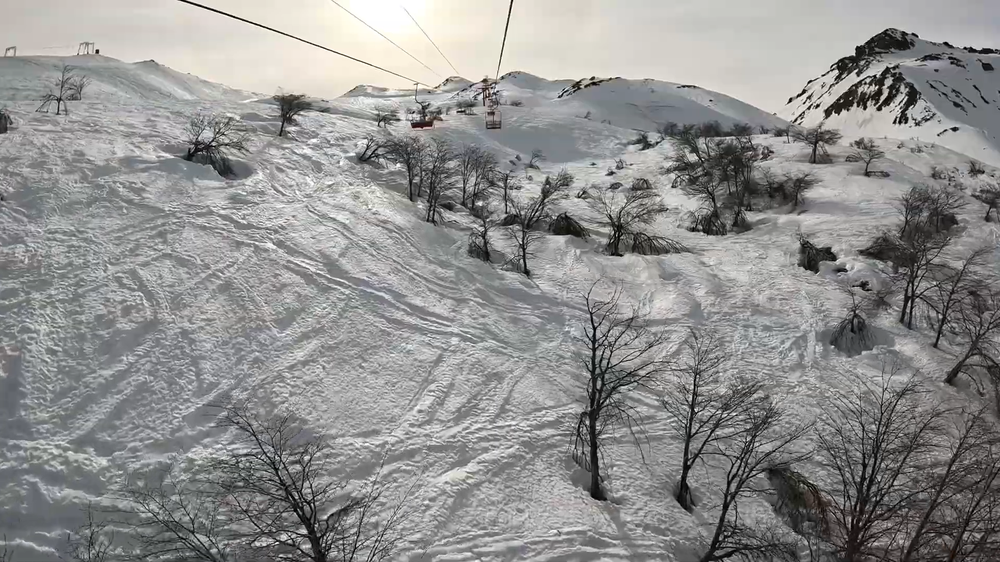
So what exactly makes Nevados de Chillán’s terrain so unique? The lower sections are below treeline and resemble the rolling hills and hardwood forests one might see in the Northeast U.S.—albeit with some decidedly unique tree species—while the upper mountain opens into wide-open bowls flanked by volcanic rock and stunning peaks. The transition between these two very different looking terrain areas is something that has to be seen to be believed (one might argue that it looks like someone pasted two completely different topographical environments on top of one another), and ultimately, the terrain diversity per acre might be the best of any South American resort we’ve visited. There’s also something to be said about the near-alpine areas right before the vegetation disappears; the lightly-spaced alpine shrubs are downright exotic compared to the pines in near-treeline areas nearly everyone used to skiing or riding in North America will be familiar with.
Mountain Aesthetic
That dramatic shift in terrain also sets the tone for Nevados de Chillán’s overall aesthetic, which is among the most unique you’ll find at a South American ski resort. On top of the natural diversity we just mentioned, the resort just has a much different character than the more commercial-feeling ski resorts further north. From the top, you can see views of lines of peaks within the vicinity of the resort, several of which are active volcanoes that top out well above where you can ski. The resort’s lifts are painted red, and while this might sound like a minor detail on the surface, these lifts add a visually iconic contrast to the volcanoes and boreal trees. The resort also feels far more local than one might expect, with very little in the way of excess buildup or commercialization. In fact, you might find yourself skiing or riding by a random hotel tucked away in the woods off a trail—or even passing some abandoned huts if you venture further off the beaten path.
TRAIL MAP
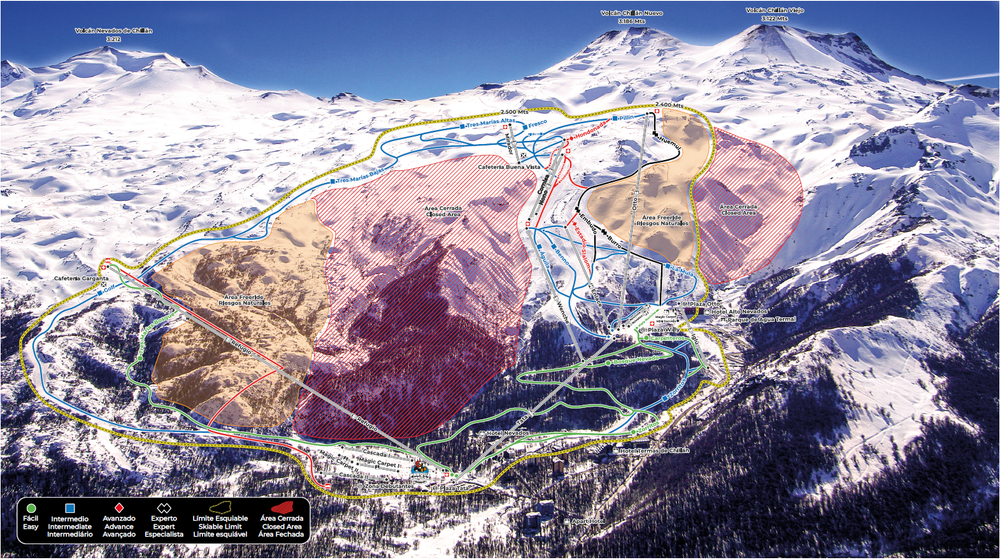
Beginner Terrain
Nevados de Chillán features much friendlier beginner options than most Santiago-area resorts, making it a stronger destination for newer skiers and riders. Both lower-mountain chairlifts serve mellow groomers that wind through the woods, and there are two dedicated beginner complexes: one with a chairlift and rope tows near the main base, and another with surface lifts at the lower base area near Hotel Nevados. That said, there’s no beginner terrain on the upper mountain, so guests will need to progress in proficiency to access the resort’s full footprint.
Intermediate Terrain
Intermediate skiers and riders will technically unlock access to all of Nevados de Chillán’s terrain areas. The resort’s blue-square runs provide enjoyable cruising terrain, all of which is consistently groomed. It’s especially worth noting the very long top-to-bottom Tres Marías/Golf run, which spans the resort’s entire vertical drop through especially remote areas and offers some of the most unique views at the resort, especially near the top in its above-treeline part. However, it’s worth noting that this long, roundabout route is the only blue route down from the resort summit—and that this trail doesn’t return to the main base without a lift ride from the lower mountain—so guests will need to try something more challenging if they want something more direct.
Terrain Parks
Nevados de Chillán does have a terrain park, but it’s really nothing special. The lower-mountain park has some small rails and jumps, but that’s about it.
Nevados de Chillán’s extensive intermediate terrain stands out across multiple mountain areas.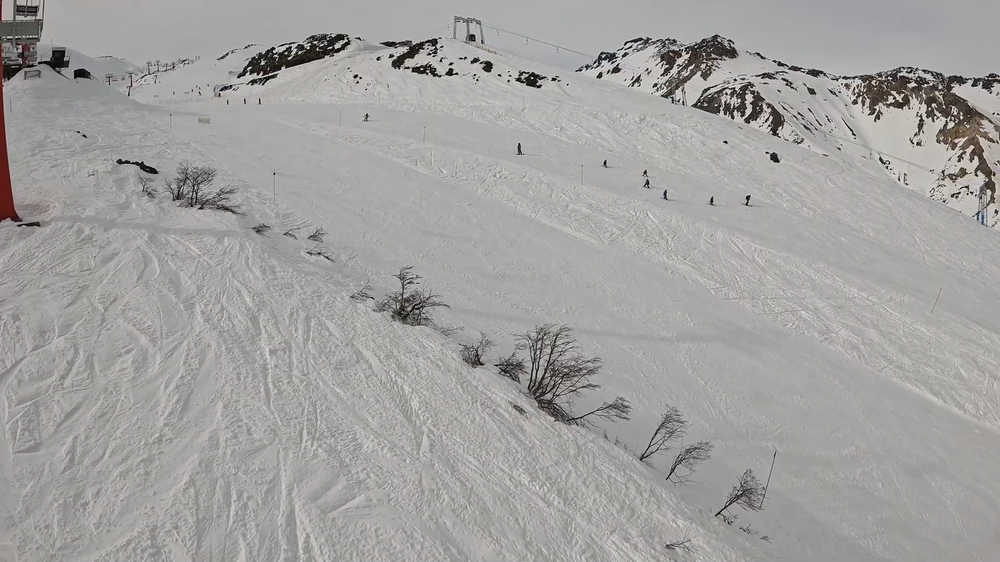
Advanced Terrain
Like most South American ski resorts, Nevados de Chillán has a trail rating between its blue intermediate and black expert runs: the red advanced trail. Only a few of these red runs exist, all of which are in the resort’s above-treeline upper mountain, and they are symbolized by a single diamond; interestingly, this diamond is black despite the trail signs being red, and it’s the only trail rating symbol on the mountain to have a different color than the sign on which it sits. Those coming from North America will find these runs to be on par with easier blacks (or maybe some harder blues out west), and they are consistently groomed, allowing for some nice speed runs.
Expert and Freeride Terrain
Where Nevados de Chillán truly sets itself apart is in its expert terrain. The first of the two types of expert terrain on the mountain is the marked double-black trail; these runs are quite steep, although they will probably be doable for most advanced skiers and riders. But where experts will really want to check out when they visit Nevados de Chillán is the resort’s exceptional freeride areas. This off-piste terrain is vast and steep, with paths through volcano-formed chutes, cliffs, and rock formations that offer some of the coolest lift-served lines one will find on the continent. For those willing to hike, the surrounding volcano peaks can also be toured. If you know what you’re doing, some of the woods surrounding the lower-mountain trails are skiable as well provided good enough snow cover. The resort has historically offered cat skiing to the peak, though this option no longer seems to appear on the website.
Nevados de Chillán’s expert freeride terrain features some of the most unique steeps in South America.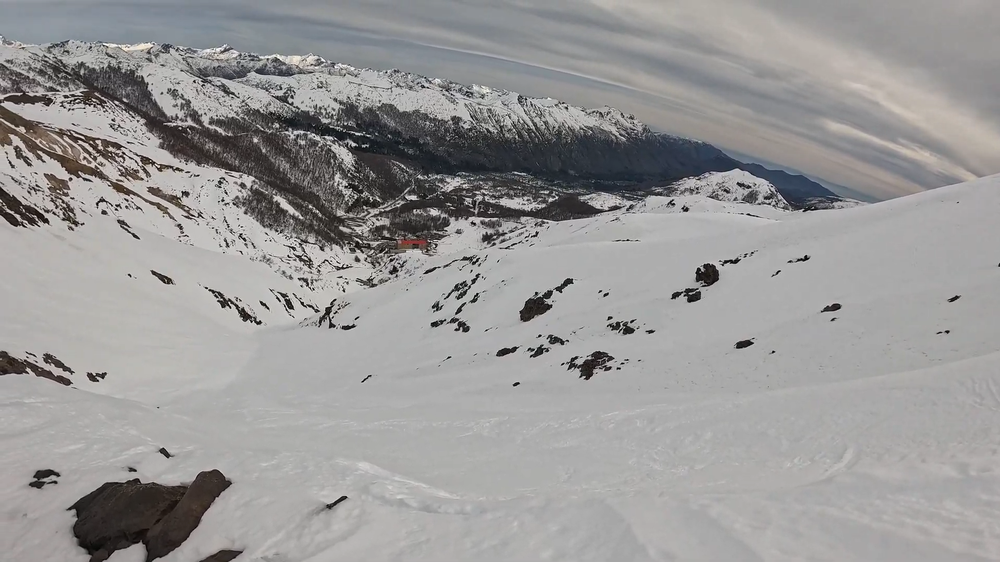
This all being said, entering these areas should not be taken lightly. They are genuinely dangerous if approached without caution; the lack of warning signs off-piste means it’s easy to stumble into serious hazards such as unsendable cliffs, rocks, natural divots, thick woods, or even streams. And perhaps most notably, these areas are especially susceptible to avalanches, and as is common throughout South America, avalanche risk can change even throughout a single day, with afternoons being especially risky. As a result, it’s critical to check the most up-to-date forecasts before tackling the freeride areas, and we highly recommend bringing equipment such as an avalanche beacon, shovel, and probe. It’s also worth noting that some especially appealing-looking terrain is permanently closed by the resort due to safety hazards; while some skiers and riders ignore these closures, they’re in place for good reason and not worth the risk.
Lifts
So Nevados de Chillán has a lot of really good things going for it when it comes to its terrain footprint. However, the resort also has several drawbacks typical of less-developed South American ski areas. Perhaps the most notable of these is the lift network, which is functional but dated. On the plus side, guests can access everything through chairlifts; this isn’t a given in South America, where surface lifts are sometimes the only game in town. However, every lift at the resort is slow, and they’re not all that comfortable either, utilizing wood or metal slats for seating. And some chairs are downright scary, involving long spans above cliffs or streams that would never get a green light at most U.S. or Canadian ski resorts. And since the resort’s vertical rise isn’t all that short, there are some particularly lengthy ride times; the Otto chair, which provides the best access to the upper mountain from the base, involves a 17-minute ride from the base to the top terminal. This lift also has an extremely loud motor at the base; in fact, it’s so loud that you’ll notice the lifties wearing industrial hearing protection. To give the resort some credit, there are mid-unload stations on some of its upper mountain lifts, so you don’t always have to ride the full length. The resort also uses modern RFID gates to load the lifts; that being said, there aren’t enough RFID gates at each lift to efficiently process the number of guests going on.
One drawback of Nevados de Chillán is its outdated lift network, which consists of slow, often uncomfortable chairlifts.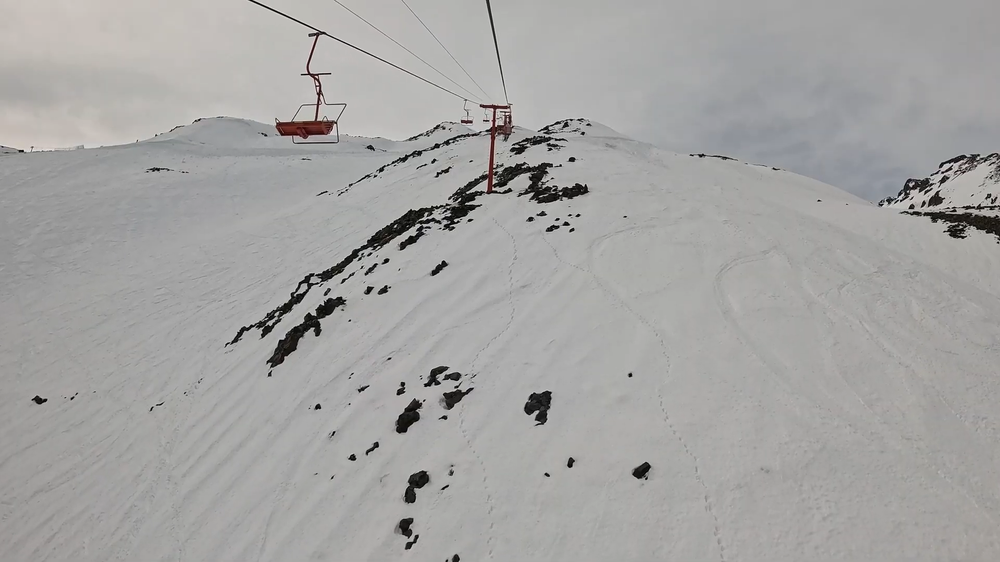
Resiliency
Another place in which Nevados de Chillán has some drawbacks is in its resiliency. Now, the resort is still on the reliable side for South America thanks in large part to its snow totals, but conditions can vary significantly depending on weather patterns and elevation. The resort’s above-treeline volcano footprint leaves much of the upper mountain heavily exposed to wind, which can lead to frequent lift closures or terrain interruptions during storms. The mountain also faces west and never gets especially cold, so freeze-thaw cycles are common. It’s not unusual to arrive to a sheet of ice in the morning, have conditions soften up to be nice at midday, and end up becoming corny or even slushy by the end of the day. The lower-mountain below-treeline terrain is much more sheltered from these effects, making it the place to be in the morning if fresh snow hasn’t fallen recently.
Crowds
At least one place where Nevados de Chillán isn’t too bad is in its crowds, at least relatively speaking. The mountain does not see the demand that the Santiago-area resorts further north and the largest Argentinian resorts across the border see, making for more reasonable waits during peak times. However, several critical lifts are low-capacity double and triple chairs, so waits do still occur throughout the day. While there are some redundancies within the lift network that help spread out crowds, this isn’t the case everywhere. Throughout a busy day, the base-to-summit Otto double chair we mentioned earlier is probably the most congested.
RECOMMENDED SKIS FOR NEVADOS DE CHILLÁN
NOTE: We may receive a small affiliate commission if you click on the below links. All products listed below are unisex.
Recommended intermediate ski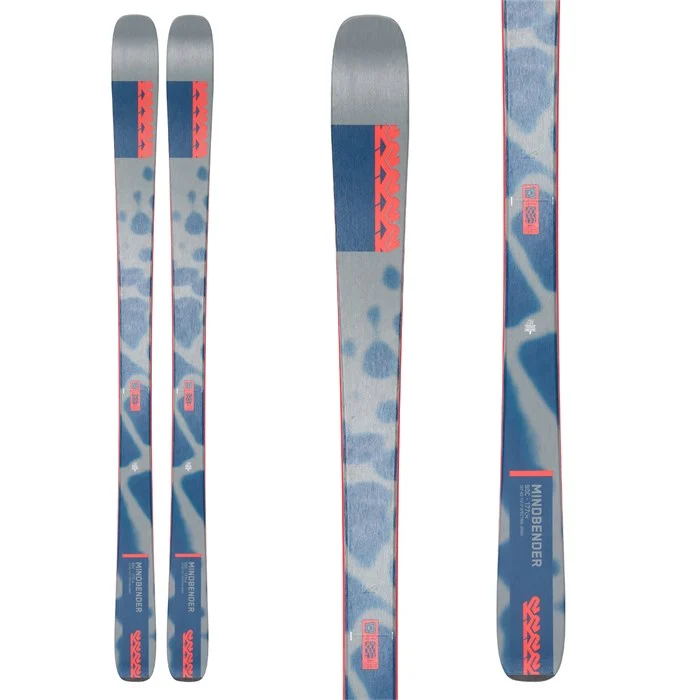
Recommended advanced ski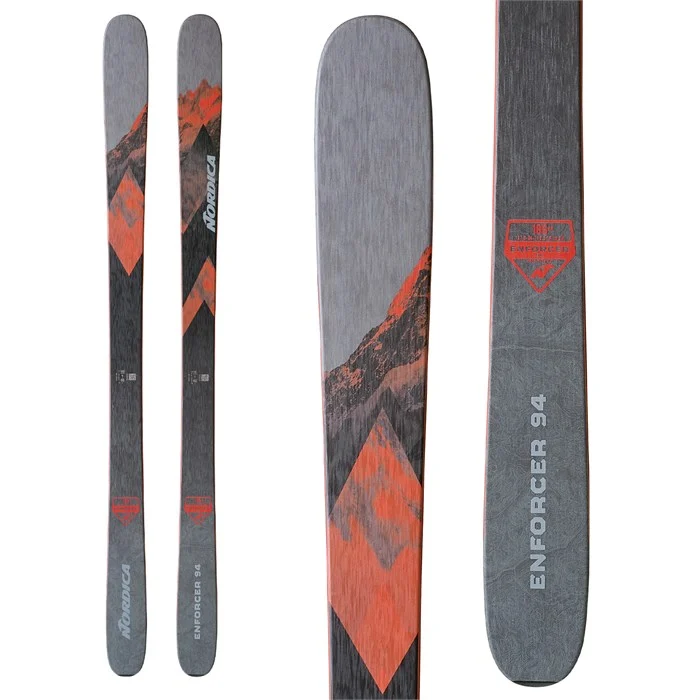
Recommended glade ski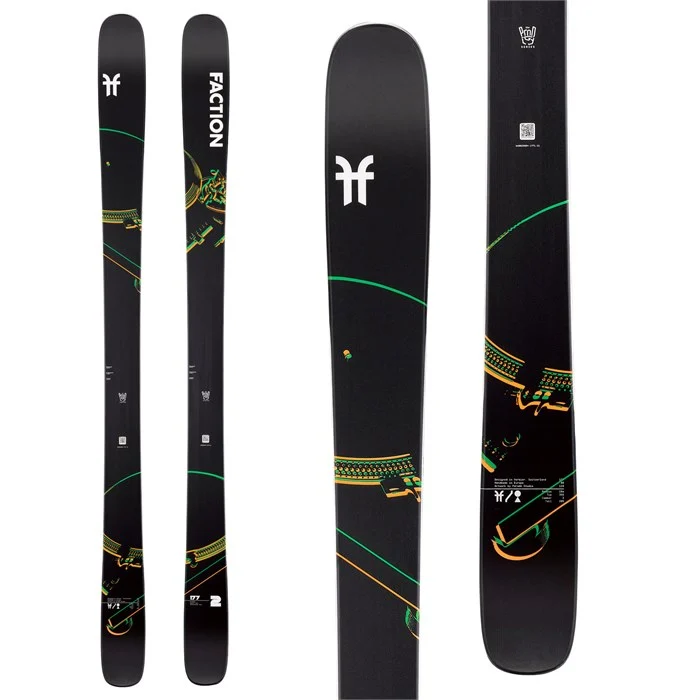
Recommended powder ski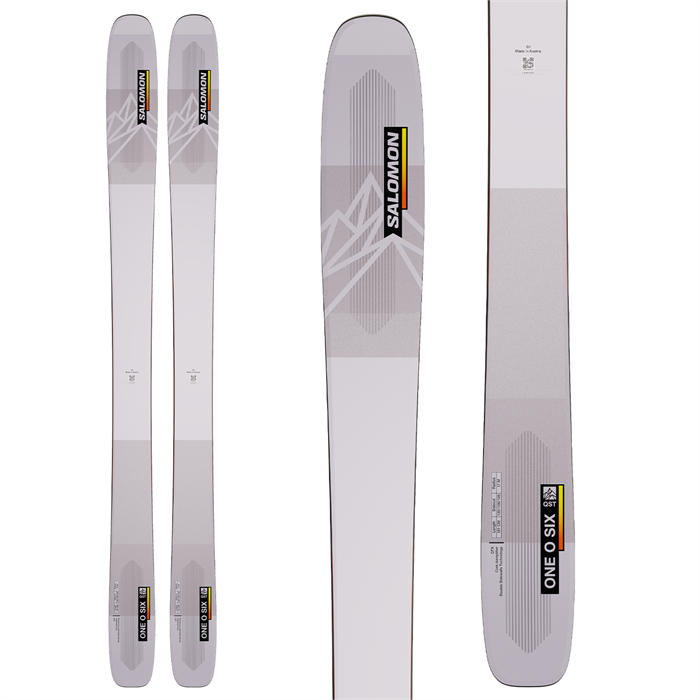
Navigation
When it comes to getting around Nevados de Chillán, the resort is more straightforward than certain other South American ski resorts with dilapidated or nonexistent signage. On normal trails, signage is mostly clear and well-maintained, although there are a few areas with comically small trail map postings. One quirk is that lift signs don’t distinguish between chairs and surface lifts, which can be confusing at first, although most guests will eventually figure out that the surface lifts are largely avoidable. As we alluded to earlier, the freeride and off-piste areas are completely devoid of signage and markings, even for hazards. When it comes to physically navigating the mountain, there are a few flat sections—especially on the way down to the lower-mountain base—although they are manageable if you keep your speed. It’s also worth noting that English-speaking staff are significantly fewer and farther between than at the more touristy resorts near Santiago and Bariloche, so it’s really helpful to know at least a little bit of Spanish.
Facilities
When it comes to stopping in for a break at Nevados de Chillán, the resort doesn’t have the fanciest lodges in the world, but they are certainly able to get the job done. Guests will find both a casual cafeteria and a fancier bar and restaurant at the main base, as well as a small hut with food and drinks at the lower-mountain base. Higher up on the mountain, skiers and riders can find a modestly-sized food and drinks joint at the base of the Mirador lift. All of these options have both indoor and outdoor seating, and you can often find music bumping too.
Nevados de Chillán’s lodges won’t blow most people away, but it does have numerous options for weary guests to rest and grab a bite to eat.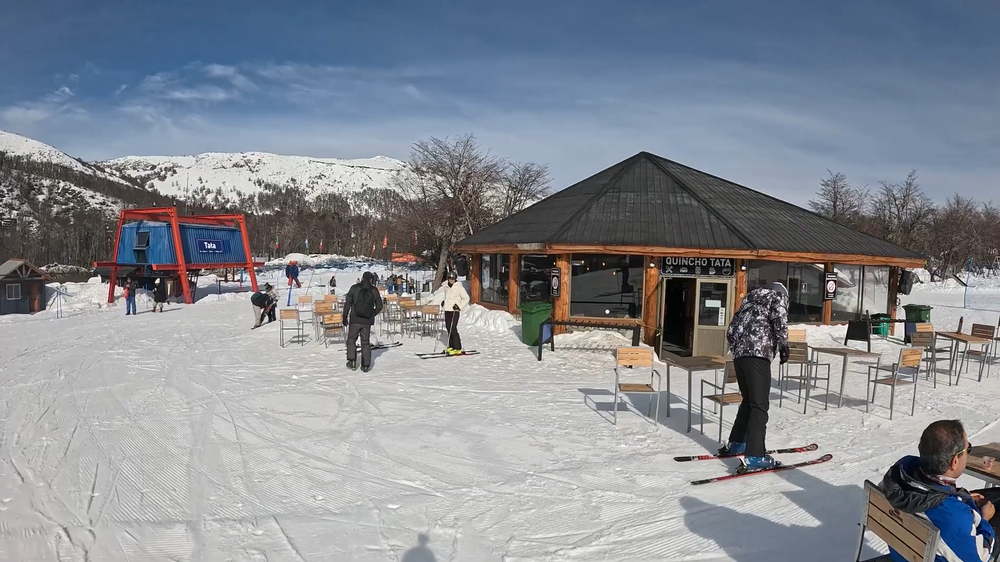
Night Skiing
It’s also worth noting Nevados de Chillán added night skiing this season, making it one of the only resorts in South America to offer it. However, the setup consists of just a single trail: the below-treeline Bosque Nevado green run. And while it’s a neat way to extend your ski day, with just one run available, it’s more of a novelty than a full-fledged night skiing experience.
Getting There
Nevados de Chillán is located in central Chile, significantly south of the main Santiago-area destinations. Those flying into Santiago can expect about a six-hour drive to the resort. A more convenient option is to take a short domestic flight from Santiago to Concepción, which is about a 2.5-hour drive to the mountain. The closest airport overall is in the city of Chillán, which is about 1 hour and 15 minutes west of the resort, though flight options there are limited. For those opting not to fly domestically, train and bus services run from Santiago to Chillán in around 5.5 to 6 hours, followed by a local shuttle or taxi ride to the resort.
A big advantage of a trip to Nevados de Chillán is that it has a significantly less sketchy access road than its Chilean competitors. That’s not to say it’s a truly easy drive—there are still a number of hairpin turns and snow conditions can warrant chains or snow tires when it’s storming—but it’s far less stressful than the notoriously sketchy mountain roads leading to Santiago-area resorts. That said, the resort does close off the access road if and when it reaches capacity, so during peak times, be sure to get there early.
Parking
Paid parking is standard in the main lots, but there is limited free parking below the base, although it’s not clearly marked. The resort charges up to 20,000 pesos, or about $20 USD, for its paid lots even on empty weekdays, which is honestly insane, and unfortunately, many visitors end up paying unnecessarily for spots that are only very slightly closer to the lifts.
While there is some free parking at Nevados de Chillán, parking at the main lots cost up to 20,000 pesos ($20 USD).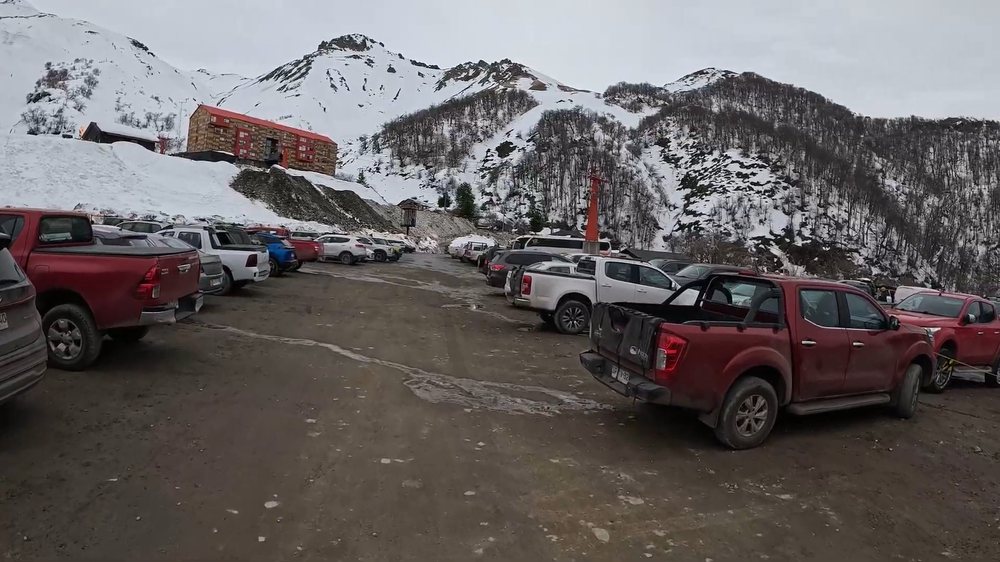
Lodging
Perhaps one of the biggest advantages to a Nevados de Chillán trip is the wide array of reasonable lodging options in and around the resort proper. Unlike most competing Chilean resorts, which have some lodging in the middle of nowhere then nothing for hours, there are plenty of hotels a short drive away from Nevados de Chillán without actually having to stay in the base village. For the widest range of lodging options, visitors should check out the town of Las Trancas, which offers accommodations ranging from budget-friendly hotels to fancy cabanas. For those truly on a budget, the Duub Hostel offers a mix of shared and private room options and is one of the few places in town that attracts other English speakers. Prices for food, groceries, and even ski services such as tunes are far cheaper than what you’ll find at other Chilean ski resorts.
But while the towns near the ski resort have some solid lodging options, there are still a number of options for ski-in/ski-out accommodations for those who prefer, with two primary hotels in the lower base village, the fairly reasonable Hotel Nevados and the very high end Hotel Termas Chillán, and one hotel situated next to the main base, the mid-tier Hotel Alto Nevados. These on‑mountain hotels offer amenities such as thermal pools and saunas with varying degrees of luxury, and like at other Chilean ski resorts, you can package meals with them too.
Many lodging options—including on‑mountain hotels—charge Chile’s statutory 19% IVA tax, but foreign visitors paying in USD may qualify for exemption, depending on the property’s currency policy; be sure to read the fine print before booking.
RECOMMENDED SNOWBOARDS FOR NEVADOS DE CHILLÁN
NOTE: We may receive a small affiliate commission if you click on the below links. All products listed below are unisex.
Recommended intermediate board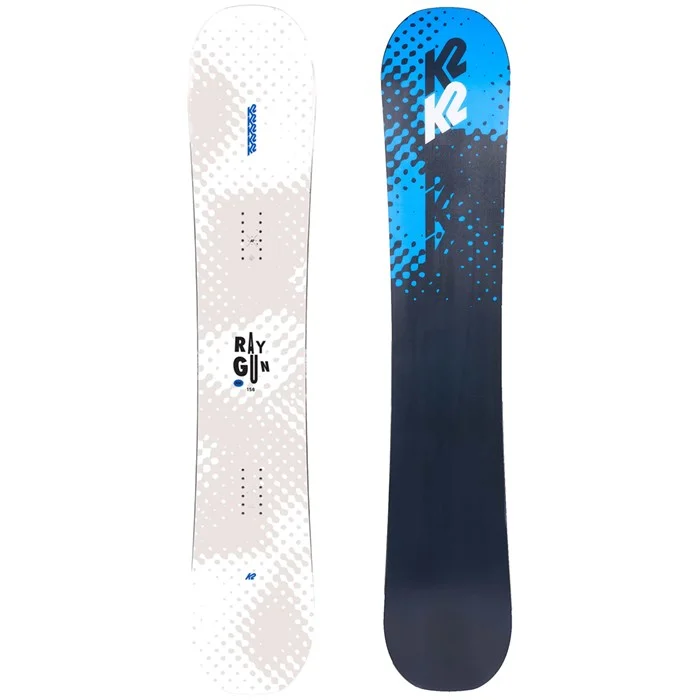
Recommended advanced board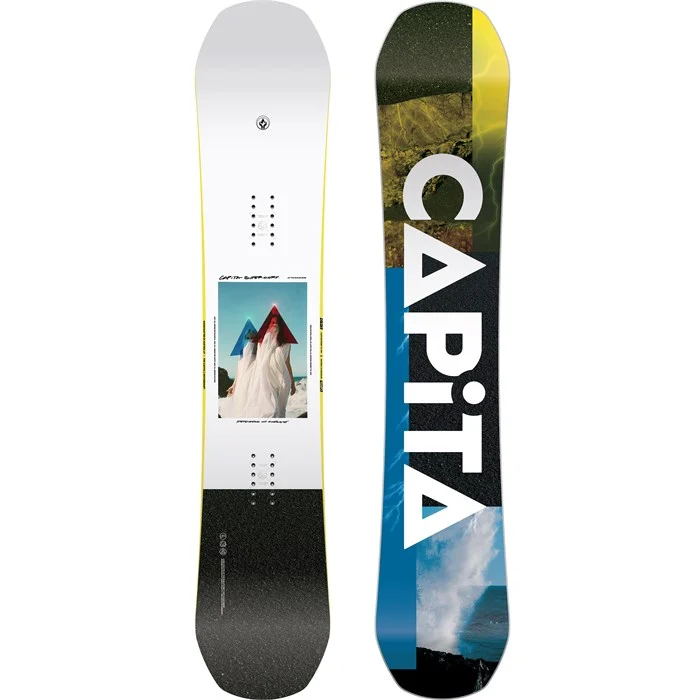
Recommended expert board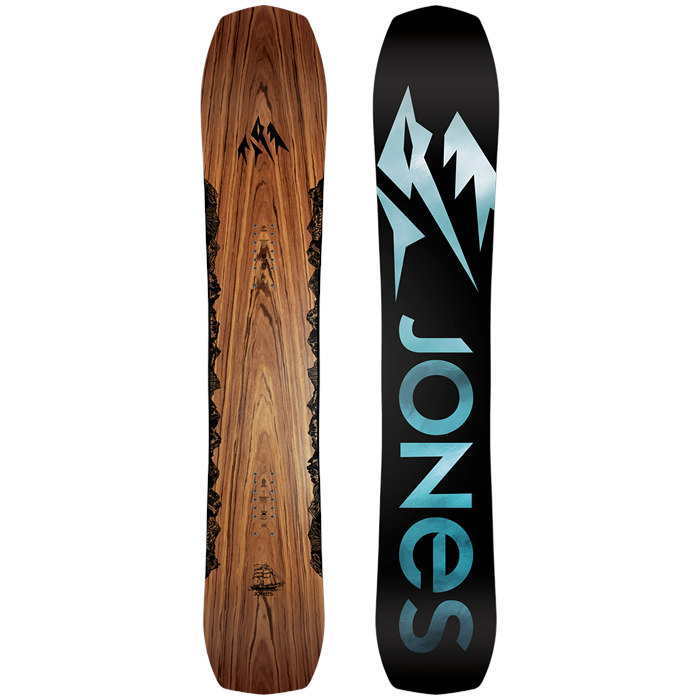
Recommended powder board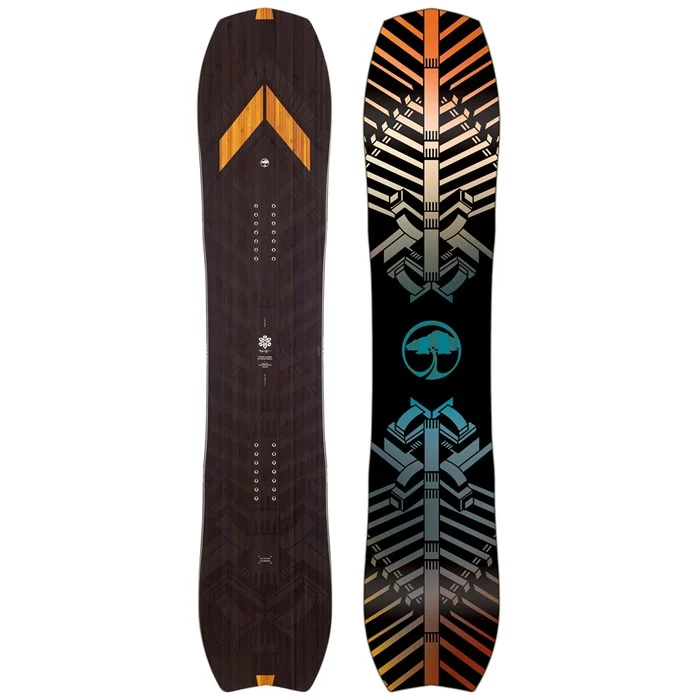
Après-Ski
When it comes to après-ski at Nevados de Chillán, the resort isn’t the liveliest in the world, but the atmosphere is much more authentically Chilean than what you’ll find at many other resorts in the country. The nearby town of Las Trancas acts as a true local ski village, complete with affordable restaurants and bars that are a rarity in South American skiing. On the slopes themselves, there’s still a laid-back bar scene with spots for live music and drinks after a day on the mountain. Families will also appreciate the unique non-ski amenities in Las Trancas, including a skate park and an “enchanted forest” theme park for kids.
But one of the coolest parts about a trip to Nevados de Chillán is the natural hot springs. These thermal pools are worth a dip, sitting just on the side of the resort and offering guests the chance for a refreshing warmup after a hard-charging day on the slopes. Hot springs passes aren’t cheap if you go for the full day, but early and sunset tickets are more reasonable. And you might want to go during those more off-peak times anyway, because the modestly-sized springs are in high demand, and lines can form during peak times.
Nevados de Chillán stands out as one of the most worthwhile ski resorts in South America, especially for those who prefer a less commercialized destination.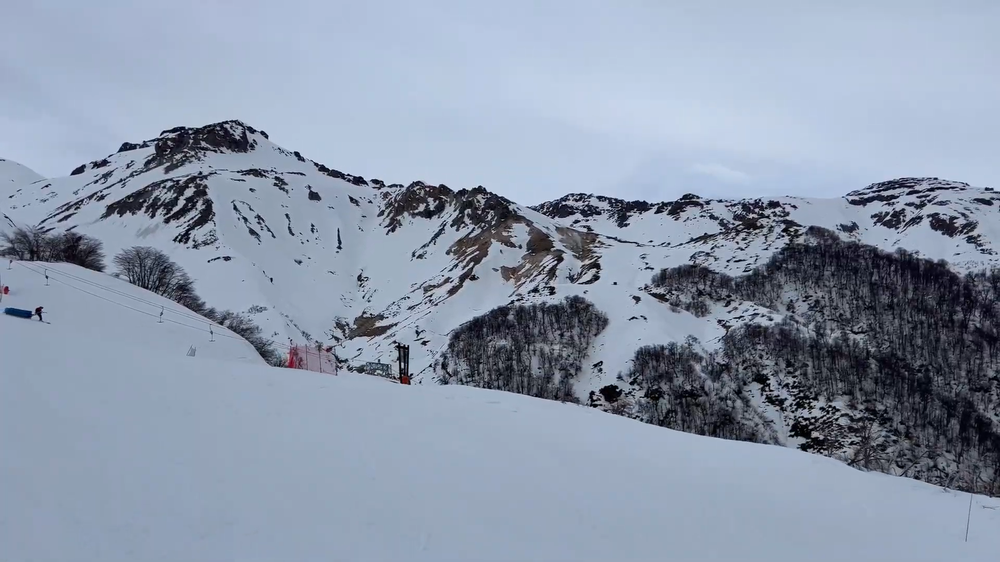
Verdict
So no, Nevados de Chillán is not without quirks—no South American ski resort is. But the mountain’s combination of terrain diversity, snowfall reliability, affordable pricing, and true local feel make it one of the most compelling ski destinations in South America. While it’s not ideal for every skier or rider, particularly those who prioritize modern lift infrastructure, it’s a must-hit for adventurous Chile travelers who want an off-the-beaten-path winter sports experience.
Pricing
Nevados de Chillán is not on any mega passes, and online lift tickets go for 75,000 CLP (~$78 USD) during select peak dates in August and 58,000 CLP (~$60 USD) other times. However, you can only buy lift tickets online if you already have a ski pass, and window prices are about 10,000 CLP (~$10 USD) more expensive. Still, given the experience for the region, this isn’t a terrible deal for what you get.
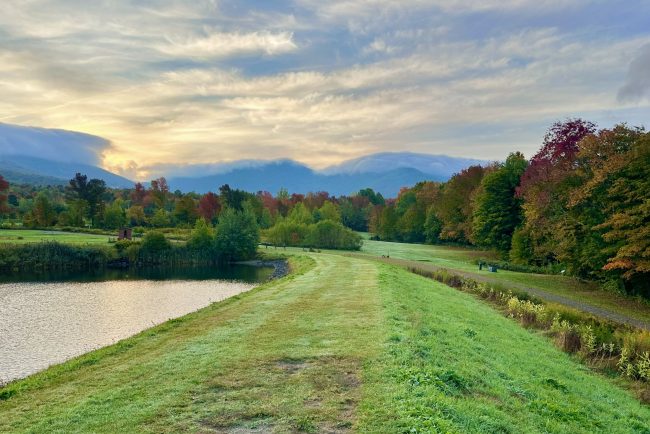
Pholiage Report
As autumn moves forward, the three mountains at Smuggs are beginning to reveal a life beyond a dream. The canopy that once felt endless and uniform is now alive with ruby waves of maple, birch, and beech, creating a divided sky between the deep blue […]
ViewsAs autumn moves forward, the three mountains at Smuggs are beginning to reveal a life beyond a dream. The canopy that once felt endless and uniform is now alive with ruby waves of maple, birch, and beech, creating a divided sky between the deep blue above and the fiery stash on the slopes. This year, the dry weather has pushed the season along quicker than usual, and the mountains in the mist are glowing limb by limb as the colors come on strong. It feels as if everything’s right for those who love the outdoors, though the pace of change reminds us that nothing remains simple for long.
Walking along the wire road, one cannot help but notice how the leaves shimmer in the low afternoon light. Each step along the path is a reminder of free moments, a chance to set your soul free. The palette this year ranges from golden horn yellow to burning fuego orange, with bursts of deep scarlet that sparkle like a theme from the bottom of a painter’s brush.
Our hillsides are already closer to peak than in years past. From the wedge of Sterling Mountain to the farmhouse fields below, the forests seem to twist with intensity. Sand and dirt crunch underfoot where rain might normally soften the sound, and the scents and subtle sounds of autumn are sharper in the dry air. This quickening of color will punch you in the eye and completely fill your loving cup.
Birds of a Feather gather above the forests, their calls mixing with the rustle of branches, as though nature itself is running through a setlist. The colors blaze on across the ridgeline, even as the season feels about to run faster than usual, there is a balance, a mercury shimmer in the light that slows you down. Standing still beneath the canopy, the joy comes clear and contact with this cycle is the thread that ties the community together.
On the quiet Lamoille Valley Rail Trail, one might pause by the river, where steam rises like a ghost against the cool dawn. The colors reflect in the water, and a modest glance captures the essence of what is happening: a landscape in motion, a split open and melt into brilliance. Like a maze of trails weaving through the forest, the season challenges us to keep up, to notice, and to taste the fleeting brilliance while it lasts. The landscape itself becomes a sample in a jar, preserved in memory even as it changes by the hour.
As the foliage nears its crescendo, it reminds us to slow down, to waste no time. Whether you view the hills from the notch itself or take in the spectacle from the valley roads, the message is the same: now is the moment. Set your course, let go of the heavy things, don’t be a slave to the traffic light, and let the colors guide you to find love and light.
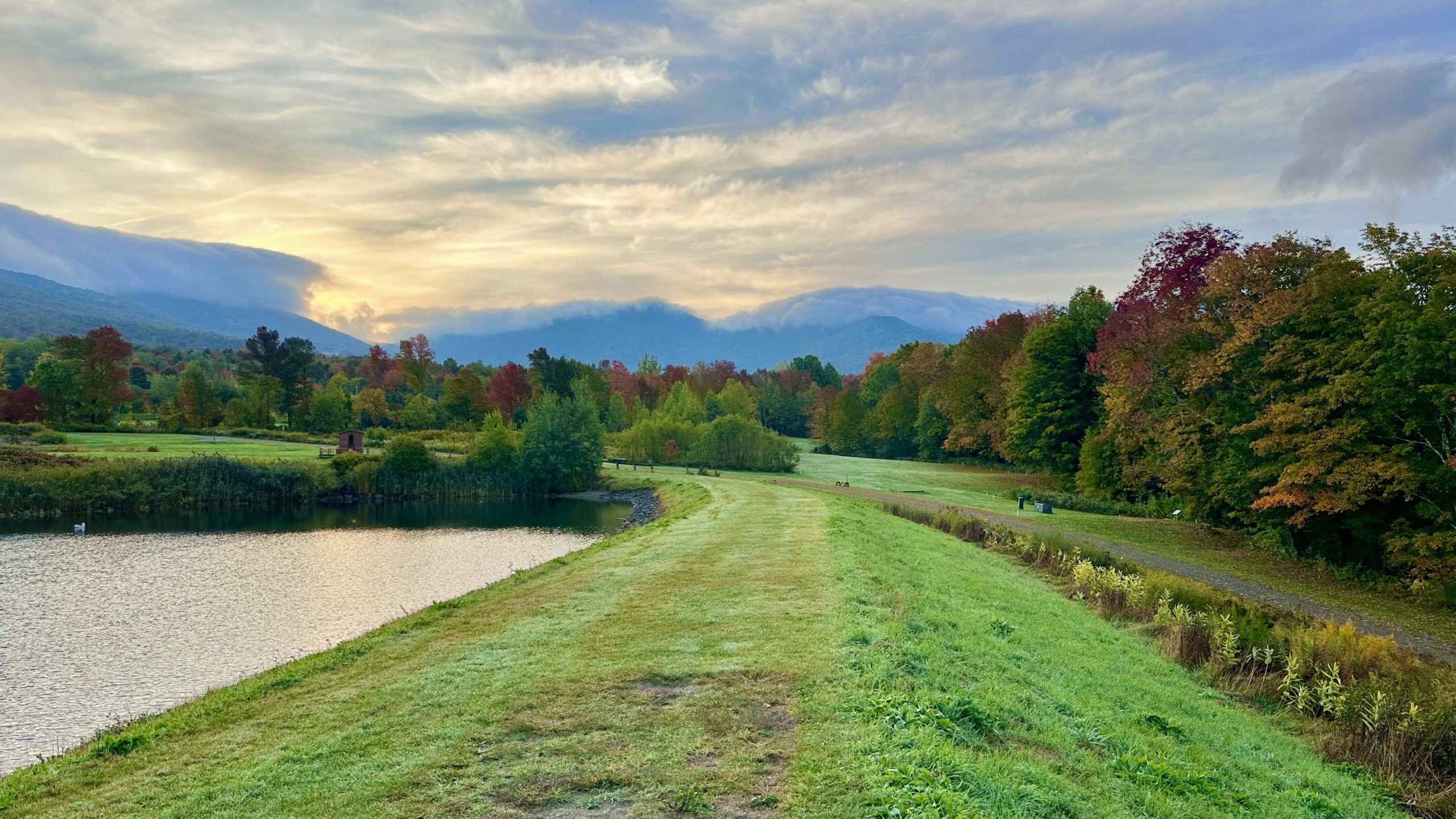
Weekend Weather
Friday – A 40 percent chance of showers. Partly sunny, with a high near 70. West wind 3 to 6 mph. New precipitation amounts of less than a tenth of an inch possible.
Friday Night – Partly cloudy, with a low around 50. Northwest wind around 5 mph becoming calm in the evening.
Saturday – Sunny, with a high near 69. Calm wind.
Saturday Night – Partly cloudy, with a low around 53. Light southeast wind.
Sunday – Mostly sunny, with a high near 76. Light and variable wind becoming southwest around 5 mph in the afternoon.
Sunday Night – Mostly clear, with a low around 56. Calm wind.
Upcoming Events
Wagon Rides
When: 9:00 am – 3:00 pm, September 26 – 28
Where: Larry’s Tree Farm, 368 Route 108 South, Bakersfield VT
Wagon Ride Tours: Join us on Saturday or Sunday for a wagon ride tour of our beautiful farm, guided by an expert who will share the story of your tree’s life and how it brings Christmas magic to your home.
Shopping: Enjoy our 1850s barn filled with Christmas cheer, gifts, ornaments, and local artists and crafters’ products.
Grab a Snack: Enjoy cocoa or hot apple cider and a snack at our concession stand.
Take a Walk: Enjoy a short or maybe a bit longer walk on our mowed roads through the beautiful trees. Take a stroll on the cut path in the woods and enjoy the birds and animals that call our farm home.
Vermont Pumpkin Chuckin’ Festival
September 28, 11:00 am – 4:00 pm
Stowe Events Field, 120 Weeks Hill Rd, Stowe, VT
Get Ready to Chuck Some Pumpkins!
Join us for a one-of-a-kind fall festival packed with pumpkin-flinging fun and friendly competition the whole family can enjoy! At the Vermont Pumpkin Chuckin’ Festival, teams of all ages design and build their trebuchets to see who can launch pumpkins the furthest. It’s all about creativity, teamwork, and that satisfying thunk of a pumpkin in flight! The day is filled with music, a lively chili cook-off, a cornhole tournament, kids’ activities, and even a volleyball tournament—making it a perfect way to celebrate autumn in Vermont. Cash, prizes, trophies, and serious bragging rights go to the top 3 teams in each of the 4 chuckin’ divisions, plus the best chili and cornhole competitors!
 Text Smuggs to 855-421-2279 for real-time alerts about weather updates, schedule changes, and more!
Text Smuggs to 855-421-2279 for real-time alerts about weather updates, schedule changes, and more!
The post Pholiage Report appeared first on Smugglers’ Notch Resort Vermont.
Most Shocking Things About Skiing in Australia
Skiing in Australia is decidedly exotic, although it does have its drawbacks. Background When it comes to a trip to Australia, the first thing that comes to mind is probably the Outback (and maybe an exotic array of animals). But a surprising thing […]
Mountain
Skiing in Australia is decidedly exotic, although it does have its drawbacks.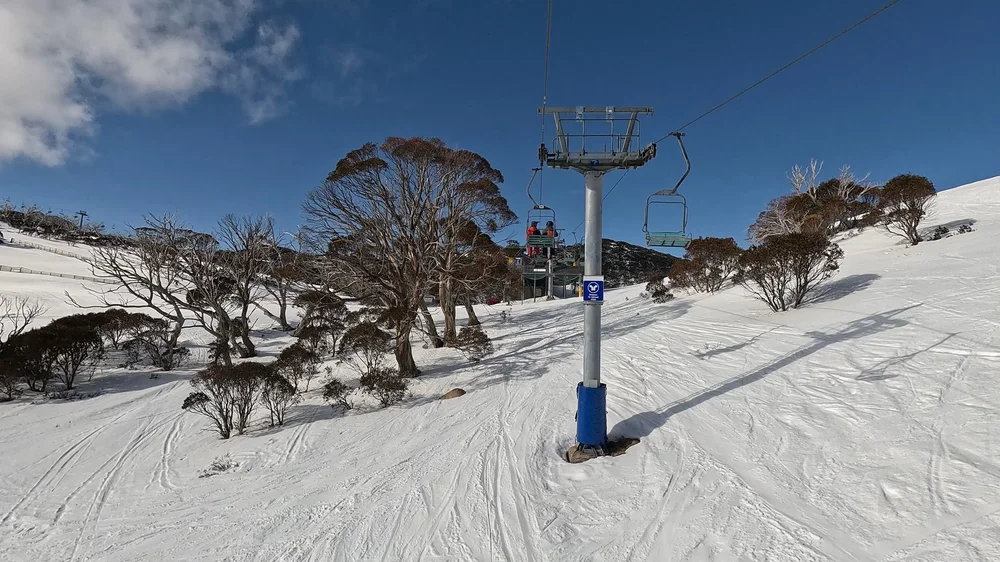
Background
When it comes to a trip to Australia, the first thing that comes to mind is probably the Outback (and maybe an exotic array of animals). But a surprising thing to the outside observer is that it actually has a sizable ski scene as well.
Yes, it turns out that not only does Australia have Snowy Mountains (this is actually what one of the ranges is called) that you can get down on skis or a board, but it actually has some genuinely competitive terrain that makes it a class leader in a number of ways for the Southern Hemisphere—and in some ways, perhaps even more unique than certain popular Northern Hemisphere regions.
So why is Australia so overlooked for a Southern Hemisphere ski trip, and is the lack of visitation justified? Well, our team just had the privilege of spending the past several days visiting all of the major ski areas in the Land Down Under, and in this piece, we’ll go through the biggest differences you can expect from skiing or riding in Australia versus a trip to North America or Europe.
Just the trees alone make an Australian ski vacation decidedly Australian.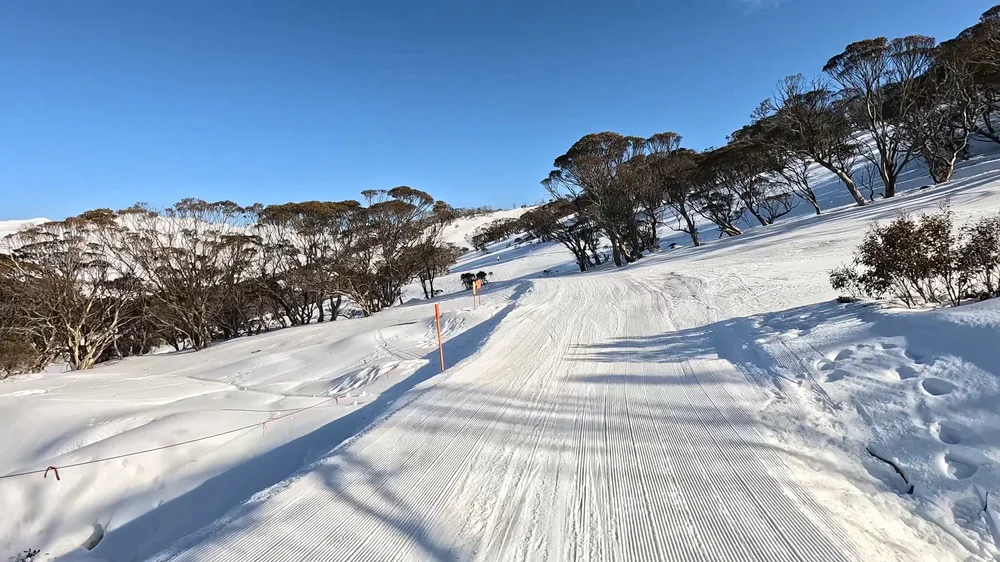
Trees and Terrain Diversity
Perhaps the most surprising thing you’ll first notice when skiing or riding in Australia is the trees. Unlike in the Northern Hemisphere, you won’t see any oaks, aspens, or even pines on the ski slopes. Instead, Australian ski resorts exclusively have gum trees, which have distinctively twisty branches and much less dense leaves than trees at a typical resort, making for a look that seems more fitting for an exotic National Geographic video than a ski run. To our knowledge, there is no other country with trees on the ski slopes like these. When conditions are right, the Australian snow gums make for phenomenal glade terrain; they are widely spaced enough to ski through at many resorts, and short enough that you can still see the scenery in front of you. However, the branches do jut out and are often very hard, so you will need to be careful to avoid them in the glades.
But despite the novelty of the gum forests, the terrain at Australia’s ski resorts stands out for more than just its glades. The vast majority of resorts manage to offer a respectable mix of below-treeline and high-alpine terrain, even when it comes to those on the smaller side. The bowls in upper-mountain areas can be surprisingly expansive, and in a good snow year, some areas might not feel out of place at a mid-sized Western North American resort.
Australia’s ski resorts have some pretty standout scenery, including this lake at Falls Creek.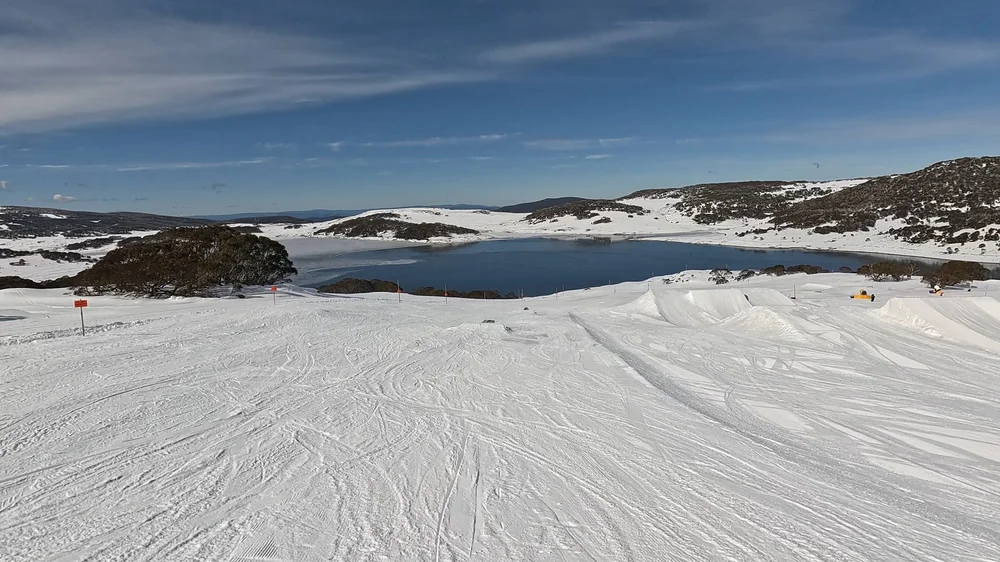
Mountain Aesthetic
Another place where Australia stands out to the outside visitor is in its scenery. The exotic trees and wide-open bowls are pretty cool in their own right, but guests will find kilometers of rolling, isolated mountain views from resort summits, panoramas that stretch over much greener valleys and lower peaks from as low as mid-mountains, and in the case of Falls Creek, even a stunning lake. Some of Australia’s ski resorts are either upside-down in nature or dip into valleys on a backside, creating much more natural views down the slopes than one might see at an equivalent American or European resort.
Resort Size
Another surprising trait of skiing in Australia is the raw size of some of its resorts. As of 2025, Perisher is the largest ski resort in the entire Southern Hemisphere, with an interconnected lift network that sprawls across multiple valleys. We independently measured the boundary-to-boundary footprint of Perisher, and it’s bigger than popular North American resorts like Alta, Jackson Hole, and Sun Valley, plus every ski resort in the East, Midwest, and Washington State. The rest of Australia’s major resorts are at least a notch smaller than Perisher, but they’re not minuscule either when 100% open, with enough to keep most skiers and riders busy for a few days.
This all being said, in terms of overall big mountain feel, Australia’s resorts still fall short of the biggest in North America and Europe. A given resort might be large in acreage (i.e. Perisher) or have a decent vertical drop (i.e. Thredbo), but rarely both. And by decent vertical, we mean respectable but not especially standout, as no resort has a rise of more than 672 meters or 2,200 feet. As a result, those looking for a huge variety of specifically long runs may be a bit disappointed.
Australia has absolutely humongous terrain parks, with professional-level features at many ski resorts.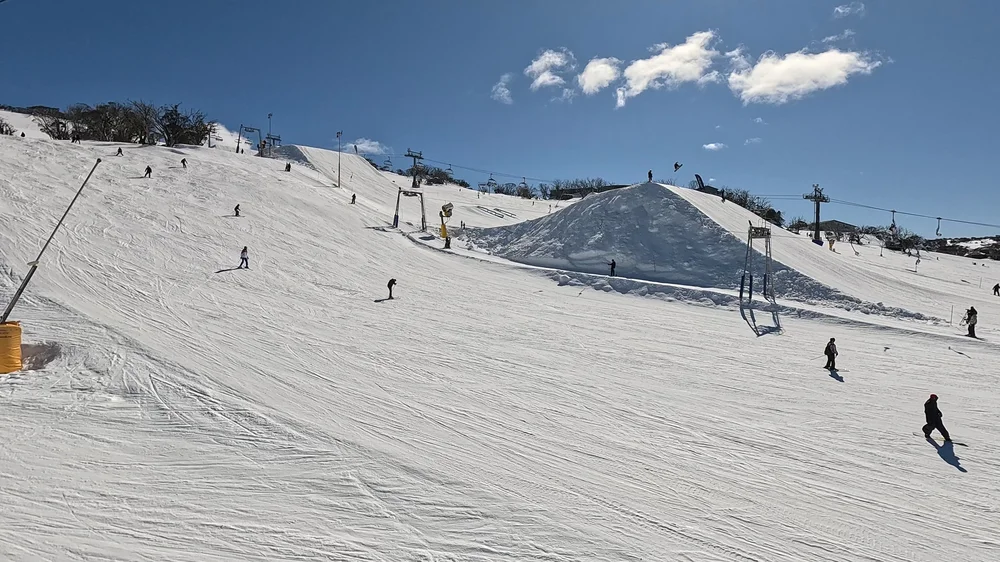
Terrain Parks and Racing Culture
But one place where Australia really punches above its weight is in its terrain park scene. The country has produced multiple freestyle Olympic champions, and it shows in how much emphasis all the resorts place on park infrastructure. No matter which resort you visit, you’ll find multiple parks ranging from small to extra-large, and you’ll often see pros practicing on the larger features even during off-peak times. And yes, unlike in the U.S., even the resorts owned by Vail have top-tier features (there are quite a few of these – we’ll touch on that in a little bit).
But Australia’s freestyle prestige doesn’t just stop at traditional features—it also excels in its mogul skiing scene. Every major resort has a dedicated freestyle mogul course, though they’re rarely open to the general public; instead, they’re typically reserved for training by competitive teams. Trails with naturally formed moguls exist to a certain extent at most resorts as well. While Perisher is oddly lacking in natural mogul lines for its size, the other four major resorts do punch above their weight in terms of advanced and expert bump runs. And at all five resorts, you’ll in all likelihood come across at least a few high-quality mogul trails, at least provided the conditions allow.
Australia does have some steep terrain, but truly extreme features are few and far between.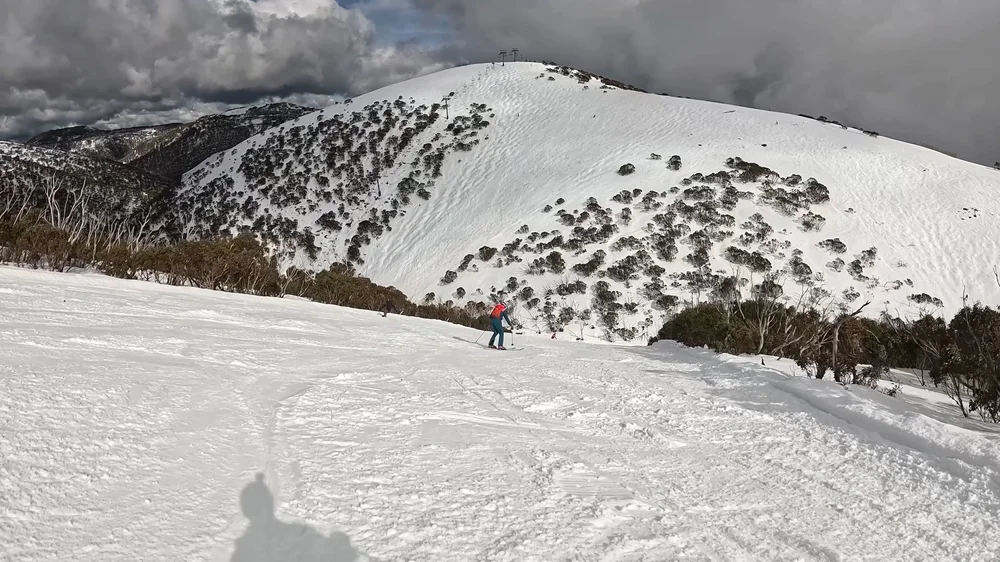
Expert and Backcountry Terrain
In general, much of the terrain at Australia’s ski resorts is mellow compared to legendary resorts in the Alps or Rockies. However, there are some legitimately challenging slopes at most of Australia’s ski resorts, including steep bowls, chutes, and even a few cliffs that, in the right conditions, will test the bounds of advanced and expert visitors. Unlike in Europe, the harder runs at most Australian resorts remain ungroomed, although a few single-black trails do tend to be groomed at some resorts. It’s also worth noting that like in North America., everything within the resort boundary is considered in-bounds unless specifically marked closed, unlike in Europe where ducking off a marked piste is technically “off-piste” and often frowned upon without backcountry equipment. This is a huge benefit and source of peace of mind for those who like skiing or riding ungroomed or gladed terrain—which is great, because Australia stands out in both departments for a Southern Hemisphere ski region when conditions allow.
But speaking of backcountry, Australia does indeed have somewhat of a scene, despite the fact that essentially no foreigners have heard of it. No, it’s not up to the same standard as New Zealand or South America, but backcountry skiing and riding opportunities do exist in Australia, and several resorts run guided backcountry tours that access less-traveled ridges and bowls, some of which can extend for several days. And if you weren’t challenged by the in-bounds terrain, the Australian backcountry also has some genuinely gnarly lines, including off the western faces of the Snowy Mountains and Victoria’s Mount Feathertop near Hotham. For those with avalanche training and the right gear, it’s sometimes possible to find high-quality backcountry lines just out of bounds and tuck back into the resort within the full lift-served footprint.
Trail ratings in Australia are the same as in the U.S. and Canada, but most resorts have additional helpful signage aids to direct guests to key areas.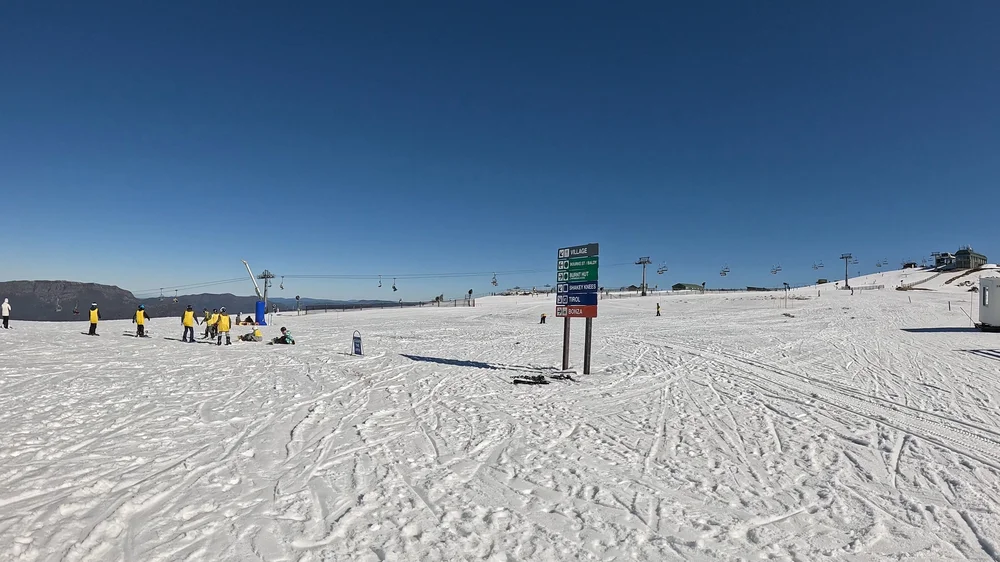
Navigation
But if and when you’re not out of bounds, you’ll probably be relying on the resorts for guidance on the ski trails. And here, if you’re used to skiing or riding in the U.S. or Canada, the trail rating system will feel familiar: the green circle, blue square, and black diamond symbols carry the same beginner, intermediate, and advanced/expert meanings. Signage is largely similar to North America’s, but Australia’s mountains generally add a couple of other helpful touches. Many resorts place tall poles along popular runs to aid with navigation during low-visibility days, which is a frequent necessity in high-alpine areas when storms roll through. But in some cases, these poles go beyond that, even guiding you toward key amenities like restaurants, lifts, or base areas. These can be a welcome orientation tool to the mountain layout even when visibility at the resort is totally clear.
Australia’s ski resorts have some modern lifts, but many are slow or outdated.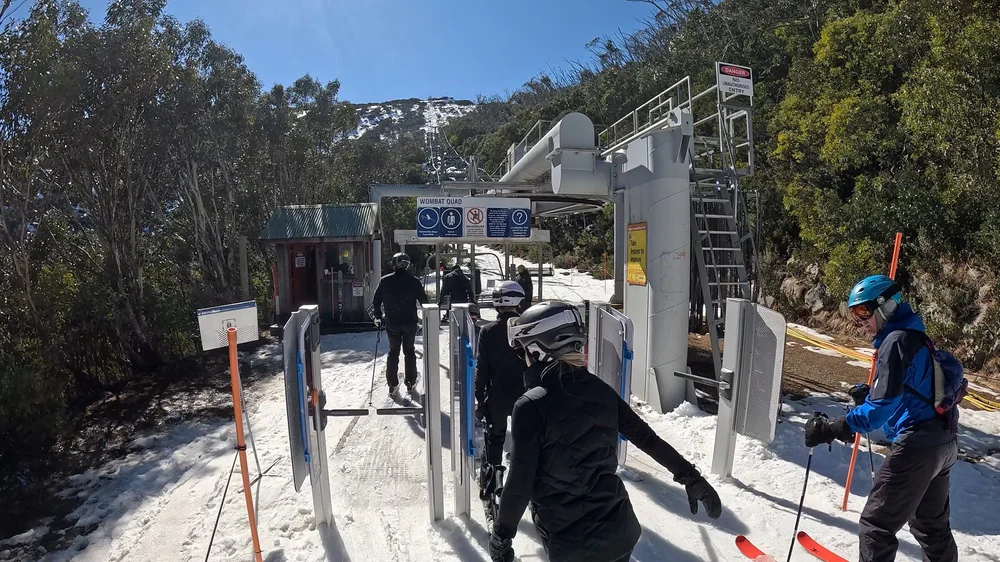
Lifts
For the most part, those familiar with U.S. skiing will find the lift infrastructure to feel pretty similar. Australian ski resorts use the same manufacturers—Doppelmayr and Leitner-Poma—and you won’t find any of the brands that primarily do business in Europe. However, the prevalence of platters and t-bars in Australia is notable. Surface lifts are common on exposed ridgelines where wind makes running a chairlift impractical, and mastering the platter and t-bar quickly becomes part of the Australian ski experience if you want to cover the whole mountain. But on the chairlifts themselves, one big difference versus parts of North America is the strictness of the safety bar rules; if you’re used to riding with the bar up in the U.S., expect to be called out immediately if you try that here.
In general, Australia’s ski resorts have some contemporary lifts, but others are slow and there’s only one gondola within the region. However, Australia is also home to one of the quirkiest ski lift experiences in the world: the Skitube Alpine Railway at Perisher. This underground train—the only ski train outside of Europe—moves skiers and riders from a base terminal near Jindabyne up through a long tunnel into the heart of the resort. The Skitube has a mid-station at the main Perisher base before topping out at the mid-mountain Blue Cow area, so it does genuinely function as a ski lift. The train cars are far from the sleek, modern trains you see in Switzerland, but the Skitube is functional, efficient, and undeniably unique. One way to put it is that riding it feels like stepping into a piece of ski history that happens to still be running.
Perisher’s Skitube may not be the prettiest, but it’s the only train that directly serves ski resort slopes outside of Europe.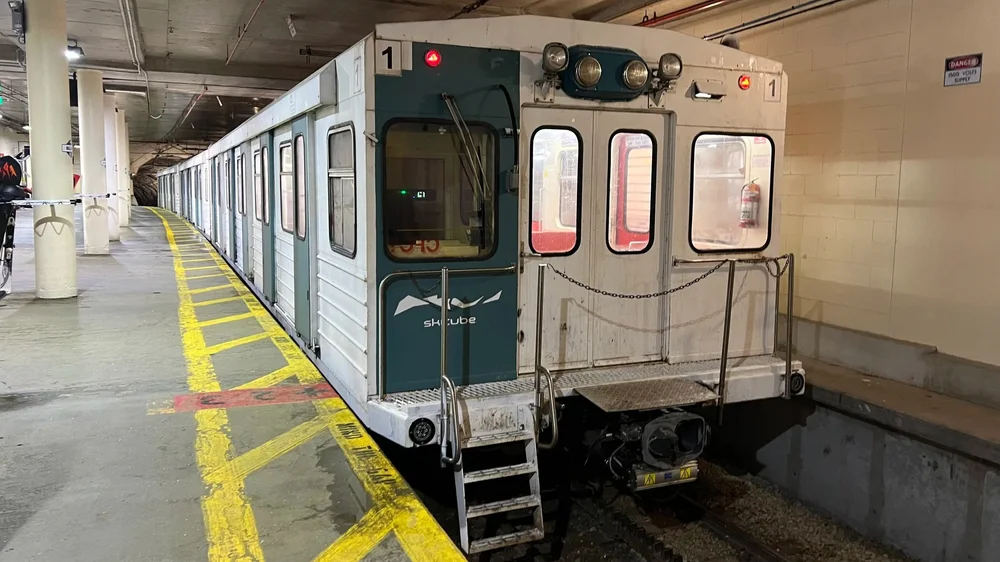
Access
When it comes to getting to the resorts in Australia, there are a number of key differences versus the alpine regions of North America and Europe—and the most obvious of these is the side of the road you drive on. Driving to the resorts is its own adjustment as soon as you step into your rental car; you’ll be on the left side of the road, with the driver’s seat on the right. The switch is probably manageable for most people, but placing the corners of the car can be hard at first. It’s worth noting that in many cars the wiper and blinker controls are reversed too, so don’t be surprised to accidentally turn on your wipers a few times while trying to signal. We’d highly recommend getting comfortable with driving your vehicle on the other side of the road before navigating the winding mountain access roads.
Speaking of access roads, there are a few caveats about driving up to the Australian Alps that ski resort visitors should be aware of. While all of the access roads are paved, they can get very sketchy. Even when conditions are clear, they are twisty with lots of switchbacks and very narrow lanes in places, with especially steep gradients to get up the final climbs at the Victoria resorts. Road barriers do not readily exist to keep you from sliding down a cliff if you lose control and swerve off the road. And when it starts storming, the conditions of these roads deteriorate quickly. Slush and ice are extremely common, and strong alpine winds can also blow snow back onto plowed surfaces, creating icy patches in places you’d least expect them. Due in large part to these circumstances, carrying chains is required for all 2WD vehicles at the New South Wales resorts, and in Victoria, even 4WD cars are required to carry them and fit them in poor conditions. So if you are not familiar with using chains before renting a car to drive up to an Australian ski resort, be sure to brush up before your trip!
A big reason why these considerations are so important is that public transportation to Australian resorts—much like in the United States—is not all that great, and can also be fairly expensive for what it is. Buses from Sydney, Canberra, and Melbourne to the resort towns are expensive and sometimes book up weeks in advance. If you’re already in the resort foothills and starting from a town just outside the resort boundary, adding the Skitube on top of a lift ticket or pass will set you back about 57 AUD for a round trip, and buses from towns below the access roads generally cost quite a bit of money too.
Australia’s ski resort access roads can be quite sketchy, and chains are required to be carried for 2WD vehicles at New South Wales resorts, and all vehicles at Victoria resorts.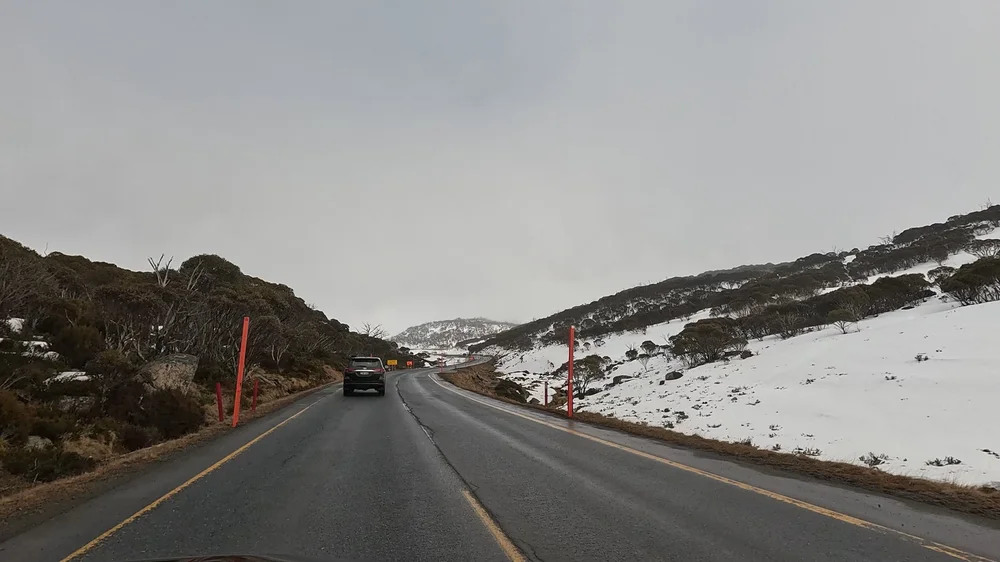
Lodging
When it comes to actually staying at an Australian ski resort, every major mountain has some sort of base village with on-site lodging. However, they don’t all function like North American ski towns. In some cases, you can drive right up to your hotel or lodge, but in others, the slopeside accommodations do not have traditional roads that lead to them. As a result, you’ll often have to take a snowcat-style shuttle to reach your accommodation, and you’ll have to load all your bags into that snowcat as well. In many cases, this shuttle ride is not included with the price of your booking. So while the novelty can be fun, it also adds time and extra costs to the arrival process.
Cost and Pass Landscape
And speaking of costs, it turns out that the sheer volume of expenses is a very critical aspect to the Australian ski resort experience.
Let’s start with mountain access. There are five major ski resorts in Australia: Perisher, Falls Creek, Hotham, Thredbo, and Mount Buller. As of 2025, Epic and Ikon have captured every single one of them, with Vail Resorts owning the first three and the Ikon Pass having multi-day partnerships with the latter two. This arguably makes the pass duopoly in Australia even worse than in America, where there are at least some independently-affiliated resorts if you know where to look.
With the pass-driven access model in full form in Australia, the country suffers from the same issues with lift ticket prices as in the United States. While passes purchased months in advance can be solid values, day tickets often approach U.S. holiday-weekend rates, with the rate for a Perisher 1-day ticket topping out at $264 AUD, or around $175 USD. And because there’s no competition outside these mega-pass operators, prices stay high all season.
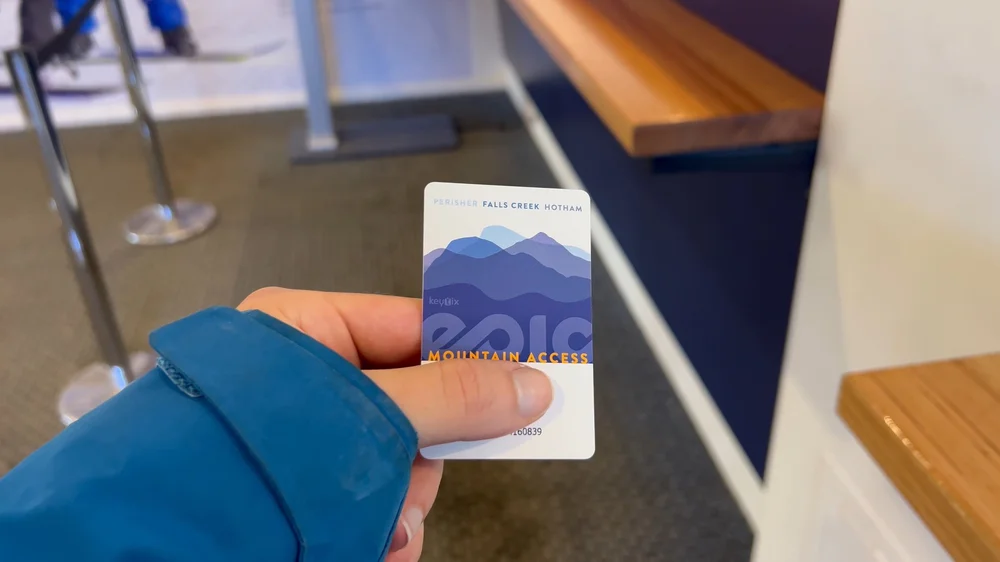
The Epic and Ikon duopoly is present at every major ski resort in Australia, and lift ticket prices are accordingly astronomical.
But while Americans can probably empathize with the ticket situation to a certain extent, the lodging situation is even more ridiculous. Staying slopeside often means shelling out $500 USD or more per night for fairly basic accommodations. Towns within an hour’s drive aren’t much better—the options in Jindabyne, which is the main hub for Perisher and Thredbo, go for steep rates that would raise eyebrows even in some high-end North American ski towns. In Victoria, prices are a bit more forgiving for off-mountain stays, but still far from “budget.” Many cheaper properties come with shared bathrooms, and camping has become a surprisingly common option for visitors looking to keep costs manageable.
Another big difference from the U.S. and Europe is that all of Australia’s major ski resorts are located in national parks. This is a major contrast with the United States, where national parks have been largely protected from ski resort development—and as a result, no major resorts are located in one. But where this becomes especially relevant to the cost equation is that driving to every Australian ski resort warrants a national park entry fee. And these entry fees aren’t trivial: in New South Wales, a one-day pass costs 29 AUD. That already sounds pretty high, but it’s unfortunately just a drop in the bucket when you learn it’s a staggering 67 AUD per day to drive to the Victoria ski resorts. Buses from nearby towns may seem like an alternative, but a one-person round-trip bus ticket is no cheaper than the park passes, so there’s really no getting around the fee, and if you’re not alone, it’s still cheaper to bite the bullet and pay for the day pass. When you take into account the inflated lift ticket rates, parking passes, mandatory chain rentals, and accommodation costs, you’re going to be paying one of the highest rates anywhere in the world to ski or ride at an Australian ski resort.
Australia’s ski resort lodging is among the most expensive in the world. Some on-site accommodations require getting there by snowcat (which is often not included with the cost of the lodge itself).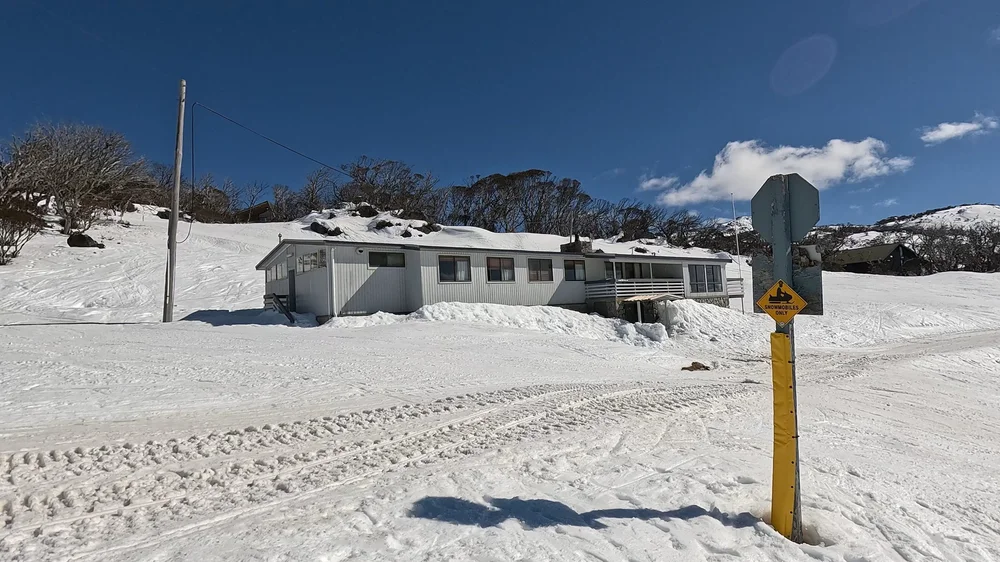
Weather and On-Mountain Facilities
Okay, so skiing in Australia is expensive. But do the country’s resorts have the on-mountain conditions to justify such a price? Well, one of the biggest surprises for some Northern Hemisphere visitors may be just how mild the temperatures are. Even in mid-winter, the coldest days rarely dip below 25°F (-4°C); fluke extremes of as low as 8°F (-13°C) have occurred at night, but they are extraordinarily rare.
Perhaps in large part thanks to the milder weather, on-mountain dining leans toward smaller outdoor cafés and bar-restaurants rather than the sprawling cafeterias common in North America.
There are also some unique food options that are probably more reflective of Australian culture than ski resort operations themselves, including meat pies, sausage rolls, and dim sims, among other things. Hot dogs are especially interesting compared to the States—as much as we love our artificial dyes up North, you have some of the most artificially red hot dogs we’ve ever seen as standard fare at most Australian resorts. Many of these same food outlets also offer Kranskys, or jumbo hotdogs that are effectively higher quality sausages. The resorts also seem to love offering chicken schnitzel, either in sandwich or platter form, although if you’ve had this in the Austrian or Italian Alps, don’t expect the same quality dish.
Australia has a ton of outside food facilities on account of its generally mild weather.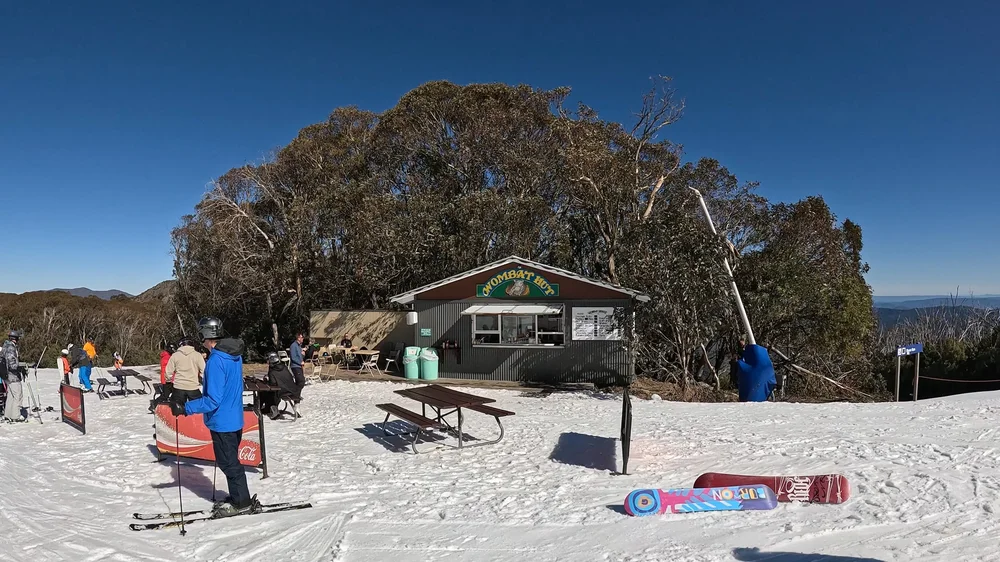
Snow and Resiliency
However, while the weather makes for comfortable conditions and a wide variety of outdoor seating opportunities, it also contributes to one of Australia’s biggest challenges: inconsistent snow. Seasonal variability is a constant headache. In a bad year or even just an average one, you’ll deal with icy slopes, limited open terrain, and thin cover, especially in lower-mountain areas. Complete bare spots can be a thing on open runs, since some resorts will still keep poorly covered trails open if they serve as key connectors. In really lean stretches, you may even have to unclip and walk across dirt. A “good” season in Australia means decent coverage across most terrain, while a “great” one means 100% of the resort stays open for an extended stretch, which is obviously far from guaranteed.
But when storms do roll through, the Australian ski slopes are heavily compounded by another factor: wind. Strong gusts are a perennial factor in the region’s highly-exposed slopes, especially above the treeline, and upper-mountain chairlifts consistently face wind holds before or in the midst of storms (as an aside, this is a major reason why surface lifts are employed so heavily across the resorts). But even if the slopes are open and natural accumulation does materialize, exposed areas often get scoured down to a hard surface.
Storm direction also plays a huge role in snow quality. In general, the more southerly, the better; pure south winds deliver the lightest snow, the biggest dumps come from the southwest, and southeast storms tend to favor the New South Wales resorts. On the other hand, the further north the storm track, the heavier—and eventually rainier—the precipitation becomes. Since the storms can come from all of these directions with substantially less consistency than typical popular ski regions, it leads to wildly varying conditions from one season to another—or even within a certain winter. The latitude doesn’t help either; Australia’s ski resorts are closer to the equator than every major ski resort in the United States and Europe, and given the modest elevation, the fact that skiing here exists at all is something of a meteorological miracle. This is probably a good time to note that thanks to their higher elevations, the New South Wales resorts are more consistent than the ones in Victoria, although the circumstances we just discussed apply to all of them.
Australia’s ski resorts get scoured by wind when it storms.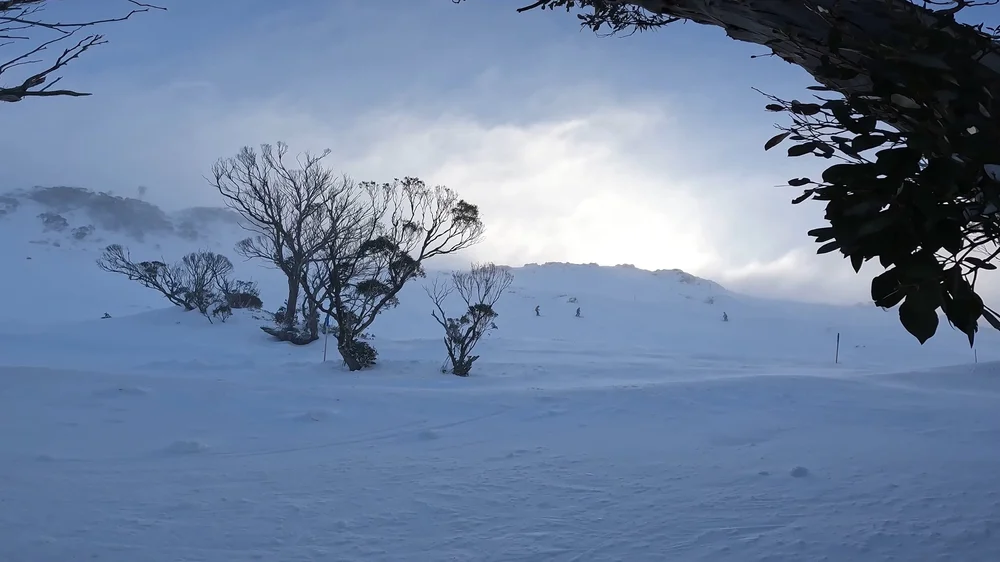
All of Australia’s resorts rely heavily on snowmaking to keep things going in bad seasons. The operations are quite impressive at some resorts, even to the point where they can produce mounds of snow or farm it even in warmer weather. However, there’s only so long this artificial base will last when it gets too hot. The baseline level of resiliency at the resorts here has increased notably in the past few years thanks to snowmaking innovations, but as with resorts almost everywhere else, not every trail is covered.
So this leads us to another thing that those of you reading from the Northern Hemisphere may have already assumed by this point: the Australian ski season is typically quite short. While most resorts usually try to spin lifts from the first week of June through the end of September, the reality is that snow cover is rarely consistent for that entire stretch. June usually feels more like a warm-up, with only a few trails open and heavy reliance on snowmaking. July tends to bring openings for the vast majority of trails, but it also brings the school holidays and some of the busiest crowds, and the snow base can still be a bit thin depending on the year. Early August is the true sweet spot—this is when coverage is usually at its peak and you’ll have the best chance of skiing a fully open resort. But by late August and early September, spring melt starts setting in fast, and while you can often still get good corn turns in, terrain closures become more and more common by the week. For all practical purposes, you’re really looking at about six weeks of “reliably” good skiing, which is a far narrower window than what you’d get in the Rockies, the Alps, or even South America and New Zealand.
Australian ski resort seasons are quite short, with often only six weeks of good conditions per winter.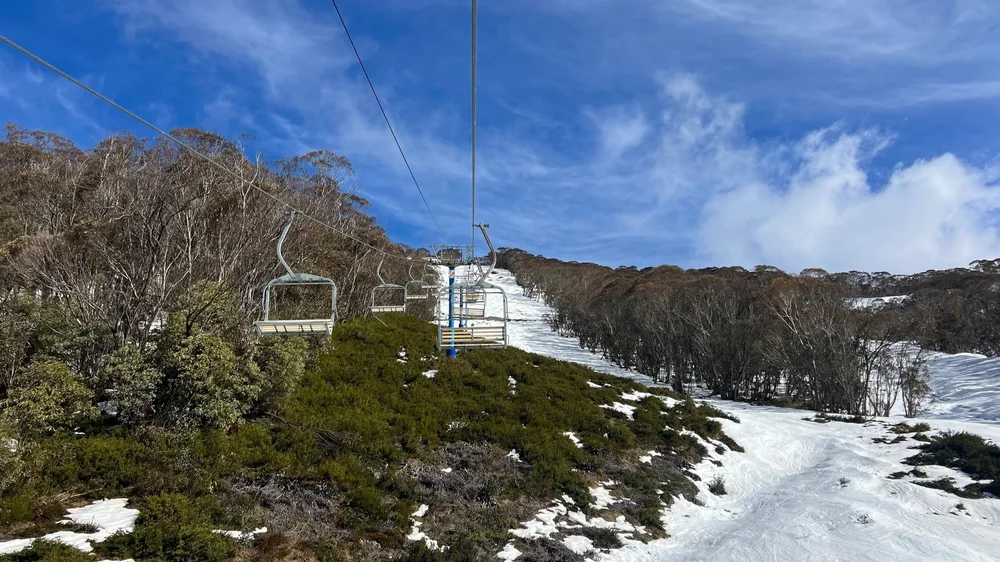
Crowds
Speaking of the crowds, the busyness at Australian ski resorts can be a bit of a factor in your experience depending on when you visit. If you come during the July school holidays, brace yourself for seemingly everyone from Sydney, Canberra, and Melbourne to be there with you—and to wait in at least modestly bad lift lines everywhere. But the true congestion on the slopes is moderated a little bit by the parking situations during peak times. This is a good thing for on-mountain wait times, but it’s really bad if you don’t have on-site accommodations or aren’t exceptionally proactive about getting to the slopes. Carparks fill really early in the morning during holiday periods, and resorts can close the road to private vehicles as early as 8am. If this happens, you can try your luck with public transportation, but this also means paying the hefty round trip per-person prices for the buses or Skitube.
But outside that July window, things calm down considerably. Midweek in August can feel pretty pleasant, with plenty of space on the slopes and generally manageable lines. Certain chokepoint lifts can still back up on August weekends at resorts like Perisher, Thredbo, and Buller, but parking is much more consistently available at least somewhere on premise throughout the day. Also, Sunday afternoons even out as people get in their cars to drive back to the cities. However, by mid-August, you’re also playing a game of chance with snow cover.
Australia doesn’t have the most lively après-ski, but there are bars in resort villages, many of which have pool and darts.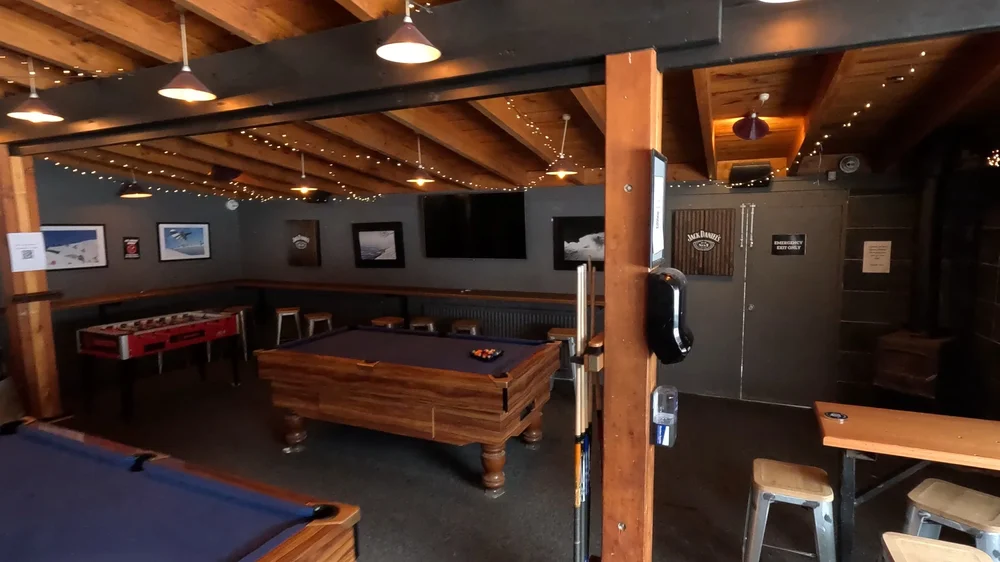
Après-Ski
Okay, so if you’re already paying all that money to ski or ride in Australia, and you’re risking some spotty conditions as well, you probably want to know what the scene is like when you get off the slopes. And to be totally frank, the après environment in Australia is generally pretty tame. But it does have its own charm, and if you like a more laid-back, pub-like nightlife, Australia’s mountains won’t let you down.
One of the things you’ll notice is that many of the base lodges and bars are owned and operated by the accommodations they’re attached to. That gives them more of a lodge-lounge feel than a standalone base complex, and it’s common to see games like darts and pool available to play—in some cases for a small fee, but others free of charge. The happy hour atmospheres tend to be friendly and social, even on weekdays, with live music a common occurrence too.
One important thing to note: if you’re not staying on site, don’t plan on “just driving down” after an après session. Australia regularly enforces DUI checkpoints on mountain roads, and enforcement is strict, especially in Victoria. The legal BAC limit is just 0.05%, and exceeding it can lead to fines, license suspension, and even imprisonment in severe cases. If you’re planning to head back to off-mountain lodging after skiing, it’s safest to skip the drinks altogether.
Finally, be prepared for competition when it comes to dinner. Many ski towns, most notably Jindabyne, have restaurants that book out fast. Even on off-peak weekdays, reservations are essential to make sure you can actually eat at a restaurant. At least if worst comes to worst, all of the Australian ski towns have readily-available grocery stores where you can buy food to cook; in fact, if you really want to save money, buying a sandwich or materials to prepare from these stores will be the most budget-friendly option.
Night Skiing
But if you’d prefer to spend your evening on the ski slopes, one thing all the major Australian ski resorts have in common is some sort of night skiing. On the surface, this is a cool feature compared to big North American and European destinations, which rarely—if ever—have skiing or riding available once the sun goes down. However, operations are typically only a few days a week, and they’re usually confined to the bunny hill or a small section of the mountain. They’re also discontinuous from day skiing, meaning you’ll have to get off the mountain for a bit before returning around 6pm. In the case of Thredbo, night skiing only happens on Thursdays and you’ll have to rent an LED flare, although this does make for a pretty cool aesthetic.
Australia may be known colloquially for its kangaroos, but its resorts stand out for its variety of birds.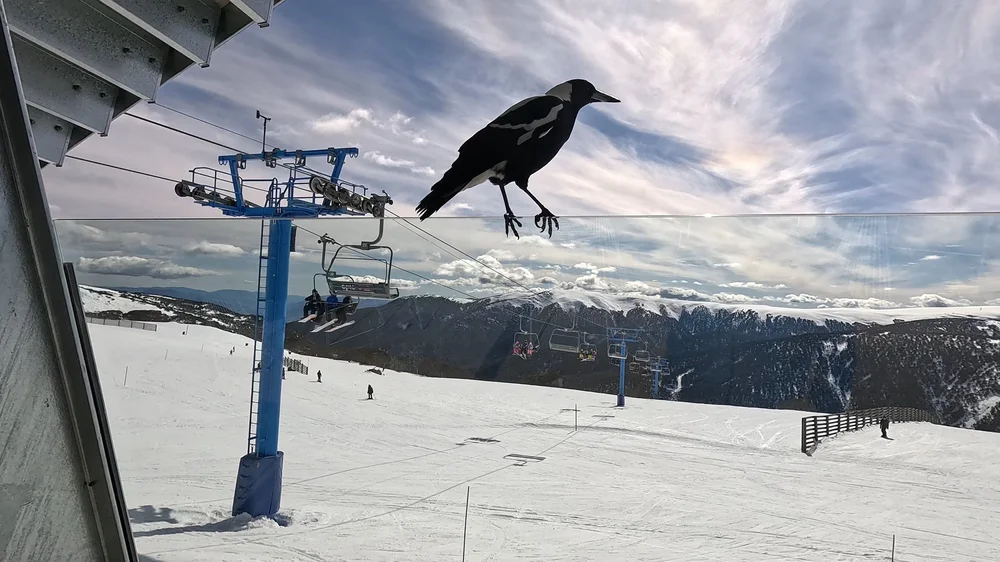
Wildlife and Culture
But absent everything else we just discussed, there’s one thing you’ve probably been thinking about this whole time: where are the kangaroos in all of this? Well, let’s just start by saying this: wildlife sightings can occur on an Australian ski trip. While kangaroos on the slopes are rare, wombats sometimes appear near village edges, and echidnas can pop up here and there too, especially at dawn and dusk. Rather than on the snow itself, however, these encounters are most likely just below the snowline as you drive up to the resort. That said, you don’t necessarily want to spot larger animals on the road; vehicle collisions with wildlife are more common than visitors expect.
But the animals you will almost certainly see on the ski slopes—and ones that bring a surprisingly exotic twang to the trip—are the birds. Alpine birds in Australia are much more colorful than the ones at most Northern Hemisphere ski resorts, and they have plainly unique sounds compared to what you’d hear in the Rockies or Alps. Besides the gum trees, these bird calls are perhaps the most obvious reminder that you are in a foreign ski country.
But even if you don’t see these exotic animals on the slopes, some resort towns are close to zoos where you can get a guaranteed viewing of them—and worst case scenario, there are animal sanctuaries available to visit on your way in or out of Australia from Sydney or Melbourne.
Final Thoughts
So when everything lines up—meaning that coverage is good, winds are manageable, and you’re prepared for the costs—skiing in Australia is actually a bit better than its global reputation suggests. The terrain variety, unique gum trees, and sheer novelty of skiing on the other side of the world all make for an experience you can’t quite replicate elsewhere. You might even see a few kangaroos on the access roads.
This all being said, the value proposition is hard to justify for most vacationers. Between the lift tickets, national park fees, lodging premiums, transport costs, and the ever-present risk of underwhelming snow, it’s a destination that often feels like it’s trying to make up for a short season by charging as much as possible. Even many Australians choose to skip their home slopes and save their money for a trip to Japan, North America, or Europe instead—and when they do ski here, it’s usually for one of two reasons: they have a ton of money, or they see it as a warm-up before heading to those more reliable destinations in the Northern Hemisphere winter.
One could easily argue Australia’s ski scene is underrated for the experience it delivers in the right year, and if you put in the work, you can certainly have some prime days here. But in general, the region is so overpriced and unreliable that most international visitors will be better off looking elsewhere.
Join Us Internationally at PeakHouse This Winter!
Alright, so Australia might not be where it’s at for your next international ski trip. But where it definitely is at is on one of our PeakHouse 2026 trips. Join us in Austria and Japan (waitlist only) in January, Canada’s Whistler Blackcomb in February, or Chile in August. And for something really crazy, we’re also going glacier skiing and hiking at the Matterhorn in late June. If you want to snag a spot, check out the links here.
What do you think about skiing in Australia? Would you take a trip here from wherever you live? Let us know in the comments below.

The GMC and FallFest
Smuggs is buzzing, and so are our courses, Fox Run Meadows and Brewster Ridge. The fairways are alive with color, sponsored flagging, and the sound of chain hits. Spectators cheer as the world’s best disc golfers let their plastic fly. The GMC and FallFest have […]
ViewsSmuggs is buzzing, and so are our courses, Fox Run Meadows and Brewster Ridge. The fairways are alive with color, sponsored flagging, and the sound of chain hits. Spectators cheer as the world’s best disc golfers let their plastic fly. The GMC and FallFest have transformed the mountain into a celebration, there’s foliage starting to pop, great food and brews, and a community that comes together to play. From sunrise rounds to sunset music, it’s all energy, all weekend, and the mountains are the backdrop to it all.
Weekend Weather:
Today: Sunny, with a high near 78. Calm wind becoming west around 5 mph in the afternoon.
Tonight: A 30 percent chance of showers, mainly before 1:00 am. Increasing clouds, with a low around 50. Light northwest wind increasing to 5 to 9 mph in the evening. New precipitation amounts of less than a tenth of an inch are possible.
Friday: Mostly cloudy, then gradually becoming sunny, with a high near 62. Northwest wind around 9 mph.
Friday Night: Mostly clear, with a low around 37. Northwest wind 5 to 8 mph becoming light and variable after midnight.
Saturday: Sunny, with a high near 60. Light northwest wind.
Saturday Night: Mostly clear, with a low around 34. Light and variable wind.
Sunday: Sunny, with a high near 70. South wind around 6 mph.
Sunday Night: Partly cloudy, with a low around 53. South wind 6 to 8 mph.
 2025 Green Mountain Championship at Smugglers’ Notch Resort
2025 Green Mountain Championship at Smugglers’ Notch Resort
Join us for the Disc Golf Pro Tour Playoff Event! Spectator tickets are available now—kids 10 & under are free with a ticketed adult.
 Please arrive no earlier than 7:30 am.
Please arrive no earlier than 7:30 am. Located at Smugglers’ Notch Resort in Jeffersonville, VT
Located at Smugglers’ Notch Resort in Jeffersonville, VT
 No cameras, flash photography, or live streaming allowed.
No cameras, flash photography, or live streaming allowed. Spectators must wear credentials, stay in viewing areas, and respect all event staff, players, and fellow guests.
Spectators must wear credentials, stay in viewing areas, and respect all event staff, players, and fellow guests. No pets or outside alcohol. Food and beverages available on-site.
No pets or outside alcohol. Food and beverages available on-site.
 Rain or shine – no weather refunds. Cancellation policies apply.
Rain or shine – no weather refunds. Cancellation policies apply.
Fiddlehead’s FallFest – Friday, September 19 & Saturday, September 20
Doors Open: 6:00 pm
Opening Bands: TBD – 6:30 pm – 7:30 pm
Friday Headliner is Vermont-based singer and songwriter Kat Wright 8:00 pm – 10:00 pm
Saturday Headliner: We’re excited to welcome back art-pop and indie-rock band from Brooklyn, NY – Rubblebucket!
Fiddlehead Beer on Draft
- Enjoy a selection of Fiddlehead Brews on draft throughout FallFest
- We’re excited to announce that Bar Hill Spirits will be joining us for Discraft’s Green Mountain Championship! You can find their signature gin & vodka-based drinks onsite at tournament-central all week & at Fiddlehead’s FallFest Friday and Saturday night.
Local Food Carts
- Selections from several local purveyors of delicious eats
Other Details
- PARKING: Please park in the main parking lot in Smuggs Village. Follow parking attendants.
- REFUND POLICY: No refunds. Event is rain or shine.
- Children 12 & under are admitted free of charge with a paid adult accompanying them.
 Text Smuggs to 855-421-2279 for real-time alerts about weather updates, schedule changes, and more!
Text Smuggs to 855-421-2279 for real-time alerts about weather updates, schedule changes, and more!
The post The GMC and FallFest appeared first on Smugglers’ Notch Resort Vermont.

September at Smuggs 🍂
September might mean back-to-school and pumpkin spice everything, but here at Smugglers’ Notch, it also marks the beginning of the next big adventure—winter prep! The mountain is buzzing with activity as we transition from summer hikes to snowy slopes. Up on the Mountain: Gearing Up […]
ViewsSeptember might mean back-to-school and pumpkin spice everything, but here at Smugglers’ Notch, it also marks the beginning of the next big adventure—winter prep! The mountain is buzzing with activity as we transition from summer hikes to snowy slopes.
Up on the Mountain: Gearing Up for Winter
As the leaves start to turn, our Mountain Ops team is shifting into high gear. Brush cutting is underway, clearing the way so your favorite trails are smooth and snow-ready when winter rolls in. And behind the scenes, we’re preparing snowmaking systems and ski lifts for the season ahead.
We’re also hiring for winter operations, including Snowmaking and Lift Attendants. These roles are essential to what we do here, and they’re a great opportunity to become part of our Smuggs family. If you—or someone you know—loves the mountain life and thrives in the snow, we’d love to hear from you.
“My first winter working lifts at Smuggs turned into a decade-long journey. I made lifelong friends, skied every day, and felt part of something bigger. It’s more than just a job—it’s a lifestyle.” — Former Smuggs Lift Attendant, now a Ski Patroller
Work Where You Play: Winter Jobs at Smuggs
Whether you’re a local, a college student on break, or looking for a seasonal change of pace, winter employment at Smuggs offers more than just a paycheck. Our team members enjoy flexible schedules, Resort perks, and a chance to create unforgettable memories for visiting families. There’s a role for just about everyone—from snowmakers and lifties to childcare pros, food & beverage staff, and more.
Boo Bash is Back! 
And speaking of family fun—get ready! The Boo Bash returns on October 25 with spooky (but not too spooky) festivities for all ages. Keep your eyes on our events calendar—costumes, candy, and community spirit await. It’s events like these that remind us how magical this place is year-round.
Passes, Badges & Big Smiles
The next deadline is Halloween, so if you haven’t picked up your Season Pass or Badge yet, secure your spot on the slopes and get ready for a winter full of skiing, snowboarding, and terrain park thrills.
Your pass or badge comes with more than just mountain access. Enjoy exclusive discounts on group lessons, equipment rentals, and sport shop purchases all season long. It’s our way of making your Smuggs experience even more rewarding—on and off the slopes.
Let’s make this winter one to remember. From first chair to last run, and snowball fights to snow angels, we’re already dreaming in white here at Smuggs. Are you ready to make some memories?
See you on the slopes (soon!)
The post September at Smuggs 🍂 appeared first on Smugglers’ Notch Resort Vermont.

Wish You Were Here
Visiting Smugglers’ Notch Resort in the fall feels like stepping into a living postcard. The mountains are matted in layers of red, yellow, and orange. The mornings have you reaching for a sweatshirt and a hot cup of coffee, while the afternoons beg you to […]
ViewsVisiting Smugglers’ Notch Resort in the fall feels like stepping into a living postcard. The mountains are matted in layers of red, yellow, and orange. The mornings have you reaching for a sweatshirt and a hot cup of coffee, while the afternoons beg you to drop a layer and invoke cravings for a maple creemee. Roads wind beneath canopies of color, while farms, fields, and woods encompass the landscape, every view looks ready to be printed and mailed. This is foliage at its best!
That’s how the days unfold at Smuggs: one postcard after another. Each stop feels like its own snapshot, the kind of picture you can imagine on glossy card stock with a quick note scrawled across the back. A line that says “wish you were here” or “thinking of you,” paired with an image that tells the rest of the story. Here’s a glimpse of what a postcard day might look like.
You hop in your car and drive three and a half miles north to Pratt Road, a dirt road that bends between wooded stretches and open fields. Trees meet overhead to veil the way, while sunlight filters down in shifting patterns. Leaves, well past their prime, fall from the trees and dance to the tune of the wind. You might see a neighbor out for a walk, kids swinging in a tire, or some deer parading across the road. Then a view opens wide across a hay field revealing ski trails that will soon be coated in white. It’s quiet, local, and unhurried, a perfect start to the day.
After a picturesque mile and a half, you’ll find Stony Grove, a family orchard where the rows of trees stretch across the rolling property, each one heavy with apples. You wander through with a bag in hand, dew covered grass wetting your Blundstones, that first bite of apple is crisp and sweet. At the barn, the farm stand is stocked with baskets of apples, shelves of jams, maple syrups, jars of pickled vegetables, and trays of baked goods warm with cinnamon. It feels like the kind of stop you hope to stumble on when you come to Vermont, genuine and welcoming.
After getting your fill of fresh made apple beignets, if that’s possible, continue your postcard day at Golden Dog Farm, where the fields come alive with motion. Golden retrievers zoom through the grass, ears flying, tails wagging, and before long you’ll find yourself in the middle of the play, laughing as one nudges your hand and another chases after a ball. If the dogs seemingly smiling furry faces weren’t enough, the Golden Dog property boasts some of the best views locally, and they produce their own maple syrup. This experience is uniquely Vermont, a memory that, like the fur, will stick with you long after you leave.
Each postcard stands on its own, the canopy of Pratt Road, the rows of apples at Stony Grove, the dogs at Golden Dog Farm. Together, they create a day that feels both complete and personal, a collection of moments that belong as much to you as they do to the place.
All across Vermont, fall delivers its colors and flavors, but at Smugglers’ Notch Resort you are right at the crossroads of it all. From here, the experiences begin as soon as you walk out your door, mountains proudly wearing their seasonal colors, quiet tree-lined dirt roads, and local businesses abounding with their season’s best. The postcards are waiting, but it is up to you to dig them up, to harvest them, to make them your own. Some come with dew on your boots and apples in your bag, others with blonde fur on your jeans and wagging tails drumming your leg. Together they create not just a picture of fall in Vermont, but your own set of memories written on the backs of postcards that always say the same thing: wish you were here.
Annual Northeast Street Rod Nationals
September 12, 8:00 am – September 13, 4:00 pm
1,500 street rods, customs, muscle cars, and street machines will be on hand at the Champlain Valley Exposition this fall as the National Street Rod Association® presents its Annual Northeast Street Rod Nationals. Almost all of the Champlain Valley Exposition, as well as many of the buildings, will be utilized for the event, which will house a large number of manufacturer and dealer displays and other attractions.
SPECTATOR ADMISSION:
$20 – 13 & older
$6 – Ages 6-12
FREE – Childrlen 5 & under when accompanied by an adult
$45 per family – 2 adults & 3 children (12 & under)
A special discounted $18 admission is available for military personnel with proper military identification, NSRA members with their current membership card, or anyone 60 years of age & older. One discounted admission per person. Discount Tickets are available at O’Reilly Auto Parts.
 2025 Green Mountain Championship at Smugglers’ Notch Resort
2025 Green Mountain Championship at Smugglers’ Notch Resort
Join us this fall for a Disc Golf Pro Tour Playoff Event! Spectator tickets are available now—kids 10 & under are free with a ticketed adult.
 Discounted lodging for GMC attendees is available through our Group Vacations team. Call 1-800-521-0536 or email groups@smuggs.com and mention the disc golf tournament.
Discounted lodging for GMC attendees is available through our Group Vacations team. Call 1-800-521-0536 or email groups@smuggs.com and mention the disc golf tournament.
 Please arrive no earlier than 7:30 am.
Please arrive no earlier than 7:30 am. Located at Smugglers’ Notch Resort in Jeffersonville, VT
Located at Smugglers’ Notch Resort in Jeffersonville, VT
 No cameras, flash photography, or live streaming allowed.
No cameras, flash photography, or live streaming allowed. Spectators must wear credentials, stay in viewing areas, and respect all event staff, players, and fellow guests.
Spectators must wear credentials, stay in viewing areas, and respect all event staff, players, and fellow guests. No pets or outside alcohol. Food and beverages available on-site.
No pets or outside alcohol. Food and beverages available on-site.
 Rain or shine – no weather refunds. Cancellation policies apply.
Rain or shine – no weather refunds. Cancellation policies apply.
 For complete event details, rules, caddiebooks, maps, highlights, and policies, visit:
For complete event details, rules, caddiebooks, maps, highlights, and policies, visit:
www.dgpt.com/green-mountain-championship/
Fiddlehead’s FallFest – Friday, September 19 & Saturday, September 20
Doors Open: 6:00 pm
Opening Bands: TBD – 6:30 pm – 7:30 pm
Friday Headliner is Vermont based singer and songwriter Kat Wright 8:00 pm – 10:00 pm
Saturday Headliner: we’re excited to welcome back art-pop and indie-rock band from Brooklyn, NY – Rubblebucket!
Fiddlehead Beer on Draft
- Enjoy a selection of Fiddlehead Brews on draft throughout FallFest
Local Food Carts
- Selections from several local purveyors of delicious eats
Other Details
- PARKING: Please park in the main parking lot in Smuggs Village. Follow parking attendants.
- REFUND POLICY: No refunds. Event is rain or shine.
- Children 12 & under are admitted free of charge with a paid adult accompanying them.
 Text Smuggs to 855-421-2279 for real-time alerts about weather updates, schedule changes, and more!
Text Smuggs to 855-421-2279 for real-time alerts about weather updates, schedule changes, and more!
The post Wish You Were Here appeared first on Smugglers’ Notch Resort Vermont.

Falling into Autumn
Welcome to fall at Smuggs! Well, technically it’s still summer, but our hours and programming have shifted into their autumn colors, fueled by pumpkin spice and the anticipation of our annual foliage spectacular. This time of year presents incredible opportunities for exploration and adventure. With […]
ViewsWelcome to fall at Smuggs! Well, technically it’s still summer, but our hours and programming have shifted into their autumn colors, fueled by pumpkin spice and the anticipation of our annual foliage spectacular. This time of year presents incredible opportunities for exploration and adventure. With cooler temps and the lowering sun, enjoyable activities include e-biking on the rail trail, paddling on our local rivers, ponds, reservoirs, or lakes, or a round of disc golf on one of our top five nationally ranked courses. Most notably, our local mountain hiking is hitting full stride. It’s also a great way to get your legs ready for the upcoming ski season. Speaking of which, did you get your season pass or Bash Badge yet? Take a peek at the Open Snow winter forecast here too… we’re loving what we’re reading!
Back to fall, NEW this season, we’re excited to announce that Smuggs is now an official foliage reporter for Vermont.com, reaching more than 250,000 seasonal webpage visitors. Our resort village sits perfectly located at the base of the much-loved Smugglers’ Notch Pass, repeatedly named one of the best places in the world to see fall foliage. Our “Views from the Notch” blog will share frequent updates on the changing colors.
If you’re not familiar with foliage stages, they’re generally classified as:
- Early – Mostly green with hints of color
- Middle – A vibrant mix of green and red
- Peak – Full blaze of autumn color
- Past – Rustic, golden tones
Each phase has its own beauty. Personally, I love Early-Middle, when the full canopy of green is dotted with brilliant red highlights, the contrast is spectacular. Locally, we often expect “peak” around the first week of October, though this year’s drier summer could mean an earlier arrival. No matter what, Mother Nature will ultimately decide when it all happens, and when you dance with her, she always leads.
Check back often for foliage reports, local event highlights, and all the latest Smuggs news. Here’s to a season full of color and adventure!
 Text Smuggs to 855-421-2279 for real-time alerts about weather updates, schedule changes, and more!
Text Smuggs to 855-421-2279 for real-time alerts about weather updates, schedule changes, and more!

The post Falling into Autumn appeared first on Smugglers’ Notch Resort Vermont.
PeakHouse vs. The Typical Group Trip
Not all group trips are created equal. Here’s how PeakHouse stacks up against the alternatives: Feature PeakHouse Typical Group Travel Trip Vibe ✅ Feels like a trip with friends ❌ Feels like a tour group Itinerary ✅ Fast-paced, curated, covers multiple destinations ❌ […]
Mountain
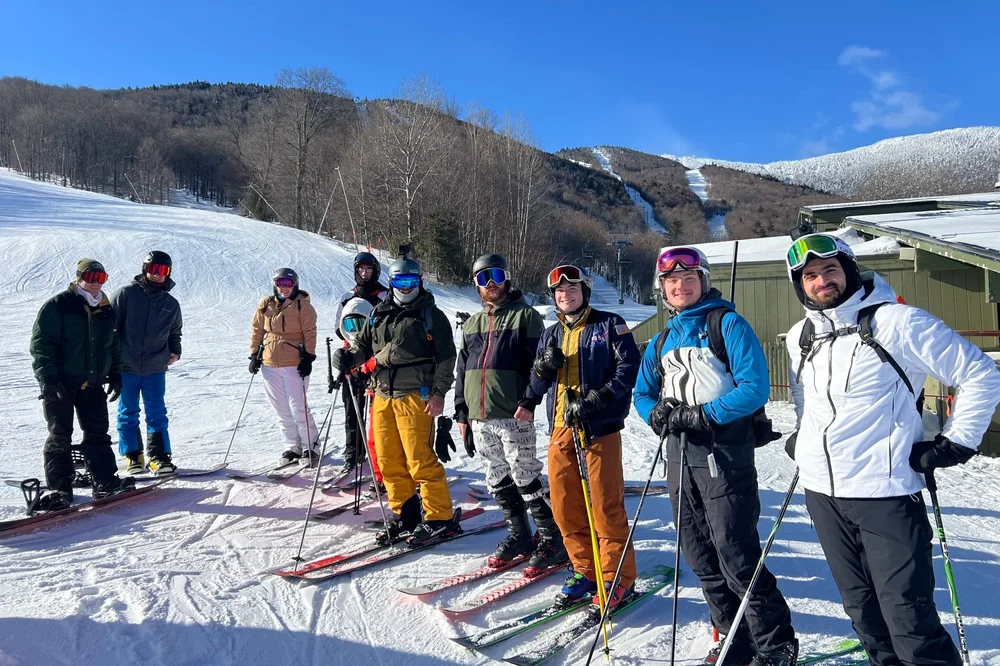
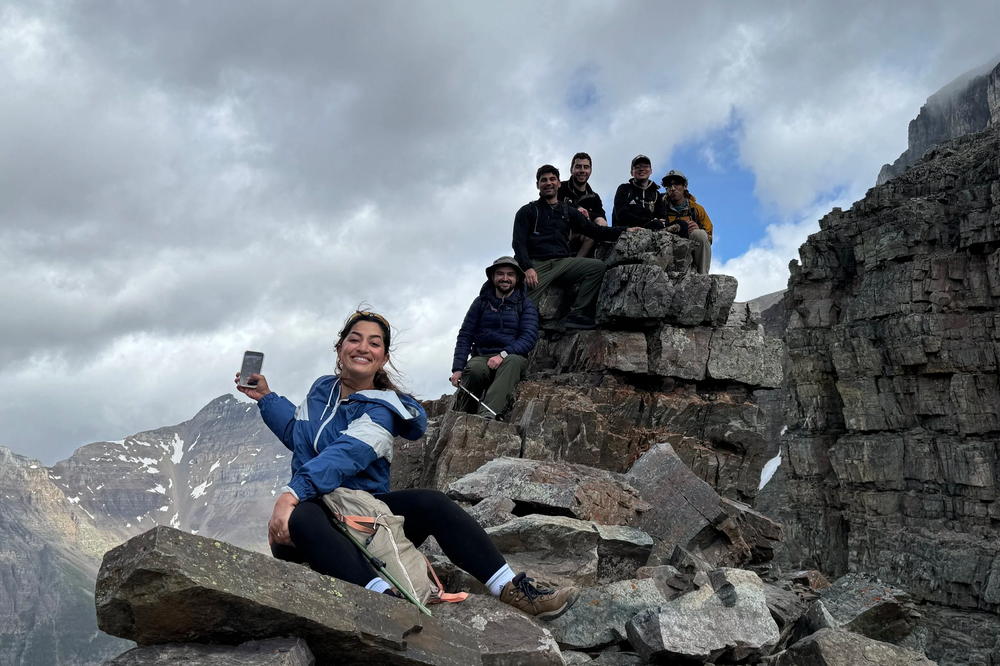
Not all group trips are created equal. Here’s how PeakHouse stacks up against the alternatives:
| Feature | PeakHouse | Typical Group Travel |
|---|---|---|
| Trip Vibe | ✅ Feels like a trip with friends | ❌ Feels like a tour group |
| Itinerary | ✅ Fast-paced, curated, covers multiple destinations | ❌ Cookie-cutter, one-area only |
| Meals | ✅ Stocked kitchens, homecooked meals, group dinners | ❌ Pre-selected restaurants or generic catering |
| Transportation | ✅ Carpools and shared rental cars | ❌ Commercial buses or vans by outsourced third parties |
| Lodging | ✅ Shared houses and apartments | ❌ Hotels with assigned double rooms |
| Flexibility | ✅ All activities are optional; spontaneous adventures encouraged | ❌ Follow-the-itinerary format |
| Community | ✅ Organically built, small group vibes | ❌ Harder to connect in large groups |
| Trip Leaders | ✅ Veteran skiers/hikers who go on the trip | ❌ Off-site managers or outsourced guides |
| Group Size | ✅ 8–25 people per trip | ❌ Often 30+ travelers per bus |
| Built By | ✅ Real skiers & hikers who know the terrain | ❌ Travel companies optimizing for scale |
What PeakHouse Guests Say
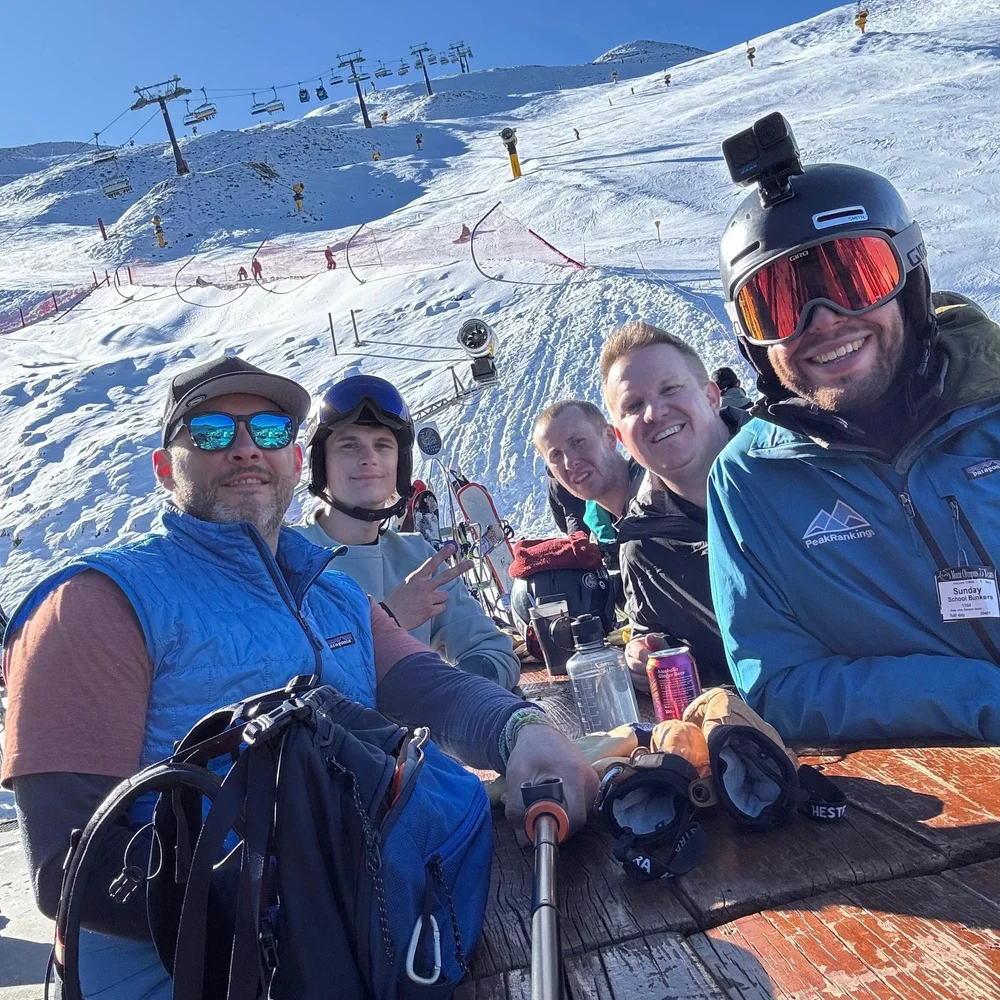
“You can put 14 strangers in a house and their love of skiing will connect them instantly. This was the best ski trip of my life and I can’t wait to do it again.”
— Grant, Ski Colorado 2025“This trip kept me motivated to keep training in the mountains after ski season and it was amazing to find a group that enjoys more active vacations. It was a great value for a trip and the memories are going to last a lifetime.”
— Sharon, Hike Banff 2025
“While I had high hopes for the skiing going into each trip, I wasn’t sure what to expect from a people/vibes standpoint. It turned out to be an amazing mix of people who all bonded quickly over a shared passion for skiing/snowboarding. I also appreciated that everyone came from different parts of the country (or different countries!), as well as different backgrounds and life experiences. The end of each trip was quite bittersweet knowing we had all enjoyed some incredible on-mountain experiences, but that our time together was coming to an end. Thankful to have made several friends through the trips with whom I’ve since stayed in touch with and skiied with later in the season!”
— Brian, Ski Italy 2025“I cannot express how happy I am to have come across these opportunities and to have taken a chance on on attending. These experiences have been a much welcomed change from the norm to discover new worlds, and even better, to go through the same experience with people who have appreciated the moment just as much. After every trip I have personally had much to reflect on: the world we live in, the snowboard and ski community, interactions with people with different life experience and from different generations, and not least of all, myself. I believe that the lessons learned here would never have been attained if not for walking off the beaten path to visit at PeakHouse.”
— Oscar, Ski Chile 2024
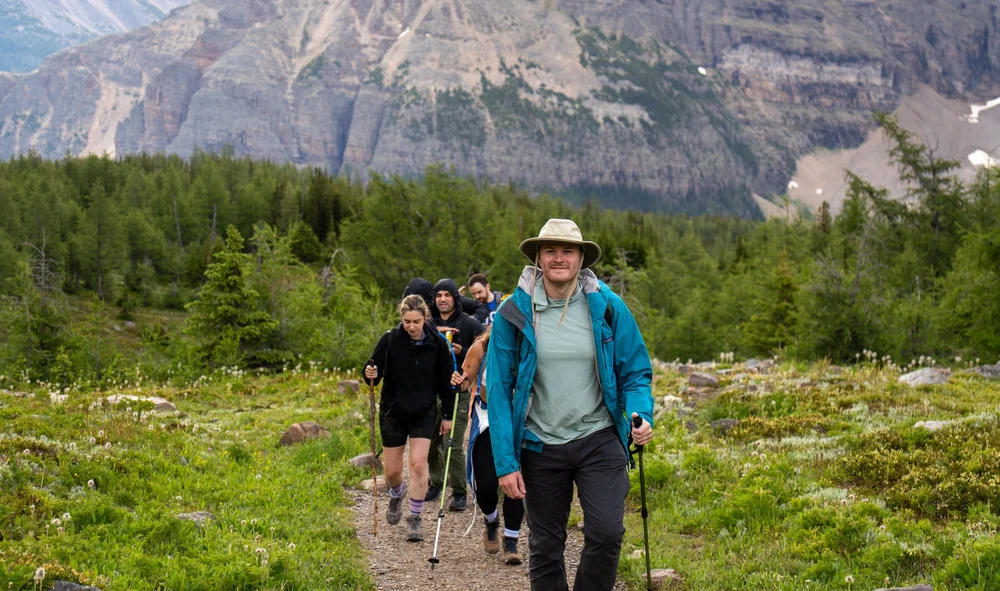
Why This Matters
Most traditional group trips offer awesome experiences overall, but they are built to make logistics easier for the company running them. PeakHouse trips are built to make the experience better for you. That means smaller groups, smarter routes, better meals, and a vibe that feels closer to a friend group than a packaged tour.
We don’t believe in commercial shortcuts. We believe in shared breakfasts, trail snacks in the car, deeper conversations, spontaneous detours, and coming home feeling like you just made 10 new ski or hike friends for life.
✅ Still deciding? Ask yourself:
-
Do I want to follow a group or be part of one?
-
Would I rather sit on a bus or ride up with new friends?
-
Do I want an itinerary that works on paper, or one that actually works on the mountain?
See upcoming trips 👇
Find your peak with us!